Mr. Money Mustache's Blog
October 6, 2025
How Unlimited Free Stuff from Amazon Almost Ruined My Retirement

 –
–It all started last winter when I innocently posted a review for a heated vest I had bought on Amazon. I was happy with this fun new way to beat the winter and wanted to share it with others, so I gave it five stars. But soon after I clicked “Submit”, I got an email from Amazon which said something like,
“Congratulations! You’ve been selected to join Amazon Vine for writing helpful reviews!”
I was already aware of the basic idea of Amazon Vine since I had seen product reviews from other people in the program – typically called “Vine Voices.” The basic idea of this program is that you can order stuff from Amazon for free, as long as you agree to review at least 80% of the things you order.
“Hey, that’s cool”, I thought, “Who doesn’t like free stuff?
Especially since I’ve already been writing product reviews out of the goodness of my heart – why not be rewarded for it?”
So without giving it much further thought, I clicked “accept” on their terms and conditions and joined the program.
And so began a saga that has taken me on a surprising journey over the past nine months causing me to:
collect a surprising amount of stuff I wouldn’t have otherwise boughtwaste a surprising amount of time reviewing it alland realize that I actually became a bit addicted to this cycle, despite the fact that I’m already retired and was absolutely not looking for a side hustle.Okay, I’ll admit that there were also some upsides. My original idea was partly to save some money, by getting stuff I genuinely would have bought anyway, in a way that sounded fun. And that did happen – I saved at least a few thousand dollars tools and materials for my construction business and the MMM-HQ Coworking space, for free. Plus, at least some of the motivation for signing up was to put myself through an experiment so I could write this blog article about it. And if you’re reading this, it looks like that happened too.
But I was still surprised at how powerful the combination of small nudges and incentives from Amazon was able to hijack my frugality instincts – and get me to do a bunch of work that wasn’t really the best use of my time.
So I thought if we review my journey and break down with a bit of Behavioral Science, we could all learn a few valuable things by laughing at Mr. Money Mustache’s folly.
Scarcity Brain and the Online Casino Effect
 –
–One of the most interesting books I’ve read in recent years is Michael Easter’s Scarcity Brain. It’s an exploration of the sneaky ways that modern gambling platforms, marketing and social media algorithms are all built upon two weaknesses in our evolutionary programming:
Our desire to double down on hunting and gathering when we get even a small taste of success (because it’s a clue that there might be more food in the area, andOur desire to gorge on rich food when it is available and stockpile resources whenever we can, even if we already have more than we need.As I look back now, I realize that I fell straight into those same traps, because the Vine program has some of the properties of a casino or a TikTok feed:
Unpredictable RewardsThe concepts of scarcity and limited timeFresh content every time you check back inEvery time you log into the exclusive “reviewers only” Vine website, you’ll see different stuff available for the taking. Sometimes there is almost nothing worthwhile – you’ll search for “porcelain plates” and get endless pages of pink plastic disposable party plates instead. You go searching for a toaster for your kitchen but instead there will be just a toaster cover with a cat wearing a witch hat. WTF!?
 And you thought I made that last one up
And you thought I made that last one upBut occasionally, there will be genuinely useful things like super nice light fixtures, tools and plumbing parts, an EV charger, and even some clothing. My favorite ridiculous Eagle shirt as featured in the Mustachianism music video was an Amazon Vine find.
 The Eagle Shirt, in the glorious final scene of Mustachianism.
The Eagle Shirt, in the glorious final scene of Mustachianism.As were a whole supply of super-realistic artificial plants, which while tacky in principle, have been amazing for hard-to water courtyard garden areas at the MMM HQ.
 Alan Donegan crafts an artificial yet beautiful garden during a visit to the MMM HQ in March
Alan Donegan crafts an artificial yet beautiful garden during a visit to the MMM HQ in MarchI also had a lot of fun roping in friends and coworkers from HQ to help and share in the bounty. I let them help me request and review stuff that they wanted, and then they got to keep it. This seemed like a win/win because we shared the work and the fun of laughing at some of the ridiculous products available.
 This totally-not-photoshopped cold plunge was one of the available scores.
This totally-not-photoshopped cold plunge was one of the available scores.Still, as I went through this experiment this spring and summer and allowed the system to coax me into doing 80 reviews so I could upgrade my account from Vine Silver to Vine Gold*, I noticed something didn’t feel quite right.
I was checking the Vine page every day for scores, even when I didn’t actually need anything. It would usually be a bust, but just often enough, something I actually wanted would come up, and I’d order it before it was too late. Scarcity and unpredictable rewards at work.
Then the bounty would come, I’d unpack it and photograph it with assembly-line speed so I could batch-write all the reviews once per week or so. For every review I did, I was spending time I’d rather spend doing something else. And for every questionable item I got, I was creating pollution and trash from its manufacturing and packaging – directly contradicting the main values of my life and my reason for writing this blog. And I saw all of this, yet I kept doing it!
So Was This The Downfall of MMM?
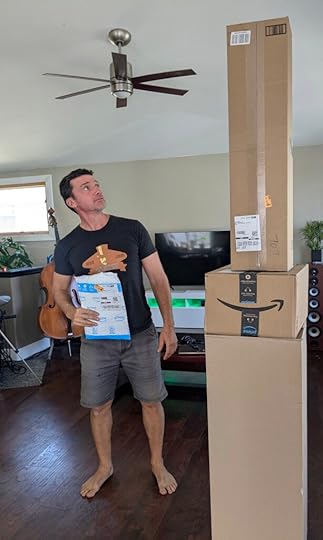 –
–During the worst of this consumerism bender, things were dire. I was getting packages almost every day and my recycling bin was overflowing with cardboard. My son and my girlfriend started laughing at some of my more frivolous purchases, so I found myself discreetly tucking away the boxes when they were around to evade scrutiny.
But eventually, I moved into a recovery stage. I had been letting this habit continue out of laziness and as a form of procrastination: it’s very easy to order shit online and pretend I’m doing something useful, and much more difficult to get moving to do the things that really make my life enjoyable.
But I’m old enough to know that hitting the running trails and the gym for my daily workouts, and making progress on all my construction projects, and focusing on the computer as a creative tool rather than an entertainment device so I can get stuff done like this blog post, are the things that bring me the most joy.
Admittedly, some of the sucky factors of the Vine program helped make it easier to recover too. For every genuinely useful thing I found like a contractor-grade extension cord, I had to scan through endless screens of trinkets which not only wasted my time but actually pissed me off at their very existence.
I also noticed some of the deliberately reviewer-unfriendly features built into the program which reminded me that we reviewers are definitely just low-wage workers rather than any form of VIP. The search functionality is crap, and there is no way to filter or sort the results, because they want you to have to look through everything and they don’t care about the value of your time.
Then there is the hilariously bureaucratic AI-based evaluation system which would occasionally flag my totally tame, factual reviews as “Not meeting our Community Standards” without explaining what the problem was. So I’d have to go in and edit my review, randomly changing a couple of words and maybe some punctuation, and suddenly the AI would be pacified and accept my review. Just dumb.
This is What “Fuck You Money” is For!
It dawned on me that for many people, this is just what “work” looks like. You are given a bunch of tasks and a bunch of rules to follow, in a system you didn’t create and don’t get much say in changing. And then as long as you crank out your TPS Reports without rocking the boat too much, you get your paycheck.
It reminded me of the Uber Driving experiment I did way back in 2017: as soon as I started working as a driver, I could immediately see dozens of improvements that could be made to the system that would make it function better for both drivers and passengers. But since I wasn’t the boss, nobody wanted to hear my ideas.
Experiences like these remind me that while I love hard work and I love learning new things every day, I greatly prefer being the boss. And I’ve gotten pretty damned accustomed to it after 20 years of financial independence, so I see no need to give it up.
Final Numbers
One interesting “gotcha” of the Vine program is that they do keep track of all the free stuff you get and send you a 1099 for its retail value at the end of the year. So it’s not really free, just discounted to whatever your marginal tax rate is (about 25% for me this year). If we peek into my account right now, this is how my 2025 is looking:
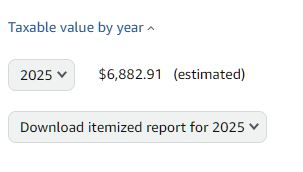
So I got about $7000 worth of stuff, and could owe up to $1750 of tax on it. In my case, about 75% of it was “sold” to my business for commercial use (construction supplies which I used on jobs or HQ renovations) so it was effectively converted into real income rather than just tax burden. Some of it was stuff I would have bought anyway for my own house which I’ll gladly pay the taxes on. But there is also probably about $1000 of pure nonsense in there as well, for which I’ll owe a tax bill of $250 as penance for my itchy trigger finger on that “Order” button.
 Friends who know me well won’t be surprised that I fell for this USB rechargeable, magnetic EagLamp.
Friends who know me well won’t be surprised that I fell for this USB rechargeable, magnetic EagLamp.Epilogue
So here we are today. While I admit that I didn’t explicitly cancel my account, I used the “Keystone Habit” trick to override the temptation to view the Vine page – mapping that browser bookmark to my daily habits list instead, a little chart which I call my “Badassity Tracker”. The net result is that every time I click it, I’m taken straight to a reminder to get up from the computer and do a quick round of exercise, so I do that instead.
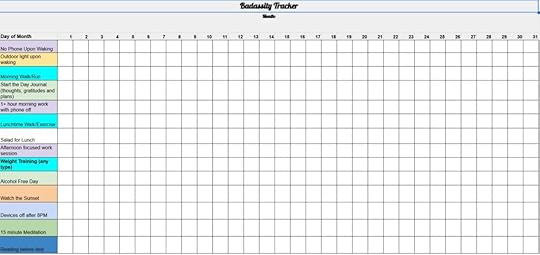 The Badassity Tracker – click for larger version if you want to save a copy!
The Badassity Tracker – click for larger version if you want to save a copy!And of course my writing of this article may be a violation of the terms and conditions of the program (“the first rule of Vine is to not talk about Vine”), so it might even get canceled on me. (and if so I’ll let you know because that would be funny story as well)
But I learned a lot about habits and addiction, and realized that this same feeling might be what drives people into One More Year Syndrome, as they keep working even when they can afford to quit. I have now coached enough people through this situation to see it is way more common than I would have ever guessed.
As with all MMM articles, there’s a real life lesson in this story. It’s not really about Vine or me or my habits, it’s about you continuing to look at yourself and your life, and always questioning your own assumptions or patterns. And asking the people you trust most for feedback as well:
Am I running my life a reasonably optimal manner, given my goals?What would you do differently if you were me?Who are some people that seem to handle these things better than me, and what can I learn from them?We will never be perfect, but the great news is we don’t have to be. All it takes is a little bit of self reflection and putting ourselves on a slightly better path, as often as we can as life goes on. We are all on a very long journey, so even a tiny course correction can make a huge difference in where we end up.
—
*(Vine Gold is not all that useful as it turns out as 99.9% of the available items seem to be the same trinkets you see in the Silver tier)
** What about the Heated Vest that started it all? Well, I still love that thing and now that fall is coming back it is already helping me be warmer in a cooler house. There are lots of good choices on Amazon, here’s one of them. Then pick out any USB battery pack to go with it, which also doubles as a very useful travel phone charger.
June 13, 2025
How to Navigate the Tariff Circus

 –
–Quite accidentally, it looks like we timed our last talk about the stock market pretty darned well. Back in February 2025, the market put the perfect cap on a multi year climb before stepping onto the wild roller coaster we’re currently riding. Since then it has seen some of the steepest drops and recoveries in history, losing a full 20% of its value at the bottom while somehow managing to end up right back near the peak as I’m writing this.
And although stock market volatility doesn’t always come with an easily labeled explanation, this time the reason seems pretty clear: it’s the Tariffs.
As our financial world has been whipped around like a circus tent in a hurricane for the last several months, almost everyone who has a stake in this country has been wondering what to make of it.
Can our president really unilaterally impose 145% tariffs on almost everything from our biggest supplier?And if so, is it really going to happen?And if so, what is the point? Aren’t free trade and low prices a good thing?And perhaps most importantly, what would the long-term effects on our economy and stock market be under varying levels of tariffs?As I write this, we still don’t know the outcome of the worldwide tariff and trade battle that our unpredictable government has unleashed upon the world. But we’re already seeing the results: businesses are bracing for massive changes, currencies and interest rates are reacting, and regular investors like you and me are wondering what the future holds for our early retirement funds. Surveying my own group of friends, the reactions span the whole range of emotions from “this is a giant Nothingburger” to “we’re all totally screwed.”
So what’s the real answer? To get closer to that, we should start with the most basic question of:
What is a Tariff?
A tariff is just a sales tax charged by our government on goods which are imported into the country. They are paid by whoever is doing the importing – meaning you if you order something like an e-bike directly from a company in China, or by companies like Amazon, Walmart, or Apple which import products from other countries by the shipload.
But in the end, the tariffs aren’t paid by China or Amazon or Apple. They are paid by you, the end consumer, because if their cost of goods increases, a retailer is of course going to raise their prices to continue to make a profit.
Tariffs also affect companies directly: if Home Depot wants to build a new store or Chevron needs a new oil rig, the tariffs on imported steel, copper, lumber and a million other components will raise the cost of these construction projects. And they raise the cost of housing, because most of the building materials in houses come from multiple countries as well.
On average, tariffs will result in higher prices for everything just like any other broad-based sales tax. And just like most other taxes, the overall effect is to slow the economy and reduce our spending power. On the positive side, all that tax money flows into the government’s pocket which could help fund the national budget and even reduce the deficit.
Of course, every government needs at least some tax revenue to function, so it makes sense to use some mix of sales, income and corporate taxes to get there. The most important part is that the levels need to be as low as possible while still keeping the country running well, and as fair and predictable as possible, so that people and businesses have an incentive to work hard and the ability to plan far into the future.
And that’s where our current tariff regime gets it completely backwards. Donald Trump is throwing around random, extremely high tariff numbers as threats, then walking them back and changing them on an almost daily basis..
Whoa, that Sounds Mostly Bad – Is There a Good Side of Tariffs?
Sometimes, a country will use tariffs to protect their own domestic industries. For example, if you put a tax on imported Hondas, then General Motors cars will gain a competitive advantage – so GM will make more money. In this example, most consumers end up losing due to increased prices and decreased selection. But at least domestic auto manufacturers and their employees are happy.
This can be strategic (for example we might want to slap a tax on imported fighter jets to make sure Boeing and Lockheed can remain in business, for national defense purposes.) Or it can be corrupt (a politician might receive funding from kingpins in the steel industry, and in return then push through tariffs on imported steel to protect the profits of US steelmakers.)
And this isn’t just a Trump or Republican thing either – Joe Biden used tariffs during his terms in an attempt to please swing-state voters. One of the worst examples was a tax on imported solar panel components (which Trump has since raised even further, proving that Boneheadedness can be Bipartisan). These are sheets of cheap glass that literally pump the cheapest energy and easiest wealth into your country for 30 years as soon as you plug them in. Cheap energy lowers everyone’s cost of living while also boosting industry. There is no good reason to block such wealth from flowing across your borders.
Can Tariffs Bring Us More Jobs?
Let’s go back to that hypothetical tax on Hondas, and let’s say it’s a big one like $5000. At that level, many buyers will start heading over to the GM dealer next door to consider what he’s selling. Sure, the GM cars may not be as good, but for five grand some people are going to settle in order to save some money.
Because of this, GM’s sales go up. So they hire more employees and build more factories. They might even develop some new models and new technologies in response to all that new demand. More people learn advanced skills and in the best case it becomes a virtuous circle.
But in exchange for this boom in the auto industry, everyone else has to pay more for slightly shittier cars and trucks. Higher vehicle prices means Amazon will have to spend more on their delivery fleet, so they will raise prices slightly on everything they sell. Somewhere a startup company or a medical breakthrough will be just a bit less likely to happen, because they are operating in an environment that is just a bit more expensive and a bit less efficient.
On top of that, with GM liberated from the hassle of competing with Honda, it will have less incentive to innovate and streamline itself. So its overall trajectory will be slower and less efficient even if its profits are higher.
This big picture effect is why most economists agree that tariffs should be used very sparingly. They almost always cause unexpected damage, decrease overall employment and slow down an economy, but sometimes (like for food security or national defense) those costs are worth paying.
So Why is Donald Trump Throwing Around Tariffs Like They Are The Best Thing Ever?
This has been confusing to almost everyone. If you take him at his word, he appears to have a Bizarro Opposite Universe belief system about economics. Donald has claimed in speeches that the tariffs will somehow make us wealthier. He’s focusing on the first-order effects like GM hiring more workers, while completely ignoring the fact that everything else in the country gets less efficient in exchange.
 –
–But when he announces larger tariffs, share prices go down, because everyone who actually runs or invests in US companies knows that of course they will make less money on average. When tariffs are paused or reduced, share prices go back up. Yet he keeps wielding the threats and we go back and forth.
It seems to be obvious to everyone except Donald himself that Tariffs are just a national sales tax rather than some clever sneaky strategic weapon, which leads to various theories that okay, maybe he knows that too but is just pretending in order to gain some influence.
The basic theory goes like this:
Unfettered power: normally, a president can’t impose taxes without the approval of congress. But there’s a loophole to that: a president can unilaterally impose taxes under the disguised name of “tariffs” in the case of an “emergency”. Furthermore, another loophole exists: there’s no strict definition of “emergency” – so if you just invent a fake one you can start imposing tariffs until congress eventually catches up to you. Which may not be for years.As a Negotiating tactic: although the primary victim of tariffs is US consumers and businesses, they can also harm our trading partners, because if you impose a high enough tax on Chinese goods, we’ll buy a lot less of them. So now you have unfettered power which you can wield against your foes, as a way of getting them to do stuff for you.As a way of controlling domestic companies: if you can cut off the lifeblood of any company (their supply chain) with just a quick post on your Truth Social account, you’re suddenly in control of the whole economy. Nobody can oppose you because you can put them out of business immediately.So right now our entire economy is subject to the whims of a single person.. And as long as this is the case, we’re just the same as any other dictatorship – something our constitution was supposed to prevent with the whole “three independent branches of government” thing.
But presidents have tried to break out of their constitutional cage and get more power many times in the past, and this is just the latest example. The real test will be if our system eventually manages to stop this abuse and put itself back in balance as it always has in the past. You can already see this fight beginning to play out in our court system, in this Economist article:
 –
–How Big are the Tariffs Right Now?
Even without the 145% nonsense numbers that were thrown around a few months ago, they are still far higher than they have been in the last 75 years or more. While it would be hard to pin down the current numbers in a stationary blog post like this one, the key thing to remember is that our current US economy is built around very low tariffs and relatively free trade.
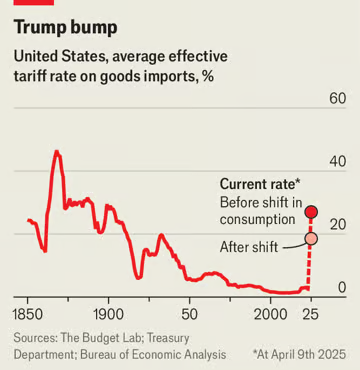 175 years of Tariff history (source: The Economist)
175 years of Tariff history (source: The Economist)Why haven’t I noticed Prices Going Up Yet?
While the US economy is fueled by a constant stream of cargo ships, as a whole we function like the biggest cargo ship of all: we have a huge inventory and it takes a while to change directions.
So in normal times, we already have several months of inventory of most things in the country. And then when all this drama started, importers started placing even more orders to stockpile things in advance before the tariffs hit. And now that they are in place, we’re importing a lot less stuff.
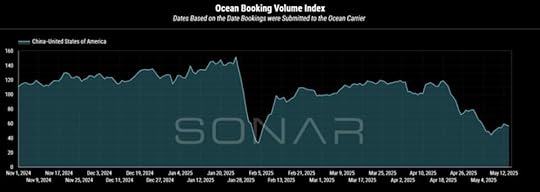 Source: the super interesting Freightwaves Ocean Shipping index (OSI)
Source: the super interesting Freightwaves Ocean Shipping index (OSI)For now, we’re still using up the stockpiled inventory, but imports have dropped significantly so we’re quickly running out of cheap goods. If that happens, we will probably start seeing shortages and price increases throughout this summer or fall. For some things like plastic party trinkets, we can do just fine without. But if we lose access to core useful things like tools and machinery, the economic consequences will be much less fun.
The Dark Side and the Bright Side
The most important phrase to remember in US politics and economics is the phrase “This too shall pass.” The only mystery right now is that we don’t know exactly how it will pass. So we could sketch out a few scenarios:
1) The current crazy-high tariffs really do stick around:
I personally think this is the less likely scenario because nobody really wants it. But just as a thought experiment, it might go something like this:
2025 inflation would more than double as the tariffs add about 4% to prices(because imports are roughly 25% of our overall spending, and current tariffs are about 16% higher than before. 0.25 * 0.16 = 0.04)Lots of companies will make changes. Those most dependent on cheap imports from China might simply go out of business. Some companies will shift to suppliers in lower-tariff countries.In some cases, US factories will benefit. We’ll produce more steel and certain auto parts here, but you’re not going to see a million factories popping up to make Nike shoes or microwave ovens – those things will just get a lot more expensive to buy. Demand for unpleasant, repetitive low-wage unpleasant factory work will increase, which should help raise the whole lower-income wage pool. But the cost of living for these people might more than outstrip these wage gains. Plus, those jobs will eventually phase back out as manufacturers continue to build robots to automate those jobs.Other countries will continue to retaliate with tariffs on US goods, which means our exporting companies will lose revenue. For just one fun example, Canada recently imposed a 100% tariff on Tesla cars from the US, almost completely destroying that company’s Canadian sales overnight.Government tariff revenue could go up by about $640 billion annually (about 15 percent of our total budget), but the reduction of economic activity and exports would reduce income tax revenue by an unknown amount – possibly an even bigger number.
2) They do end up being just a negotiating tactic and we go back to mostly low tariffs.
The stock market would stage an enormous “relief rally”Companies will gradually start to relax and go back to the way they were, allowing for more planning and hiring to resumeWe will escape with just a few hundred billion dollars of lost economic activity and a moderately large hit to our credibility as a nation, which will fade over time just like everything in politicsSome of the “deals” which are part of the negotiations (for example, lower tariffs in other countries) may have benefits for US exporters, helping boost our future tradeIn other words, the best way to win the tariff game is not to play it.
Just as much of US prosperity is built upon our huge population of 330 million people living in 50 states with open borders and no trade restrictions, all (friendly) countries of the world can benefit from the free exchange of goods, services and even people. We’re all human beings and if we treat each other with a collaborative respect, we all grow richer.
Epilogue: Is it Almost Over Already?
I started writing this article on April 2nd, when Donald announced his “Liberation Day” and the stock market reacted with the biggest drop since 1932. Some people panicked and locked in big losses despite decades of warnings from your favorite financial bloggers, like this unfortunate soul in the comments to a JL Collins post:
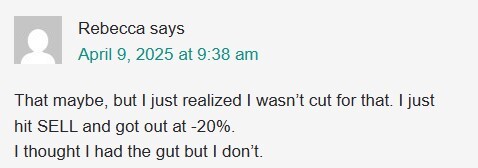 Nooooo!
Nooooo!–
But as I watched over the next two months, we have bounced our way back up – with each drop in proposed tariffs triggering a corresponding increase in stock prices (a measure of investor enthusiasm of how bright our future looks).
Right now, the US stock market is just about back to its all-time high. This doesn’t match with our current level of tariffs, which are still about seven times higher than they were before the circus opened. But it shows that investors believe it’s all going to end with a truce and a resumption of free-ish international trade.
If they’re wrong, the roller coaster ride will still have some more fun in store for us. But as long as we eventually end our current experiment in “emergency” tariff dictatorship and get back to functioning as a democracy, things should be just fine in the long run. I’m still 100% invested myself, so that’s where I place my bet.
The Biggest Lesson: Don’t Form Your Opinions Based on News Headlines
Decades ago in a brighter age of journalism, there may have been a time when headlines were designed primarily to inform us, with just a bit of sizzle and spice to pull in our attention. Unfortunately, nowadays the priorities have flipped where the primary goal is attention, and accuracy carries little or no weight. Even a totally inaccurate article makes money for the publisher.
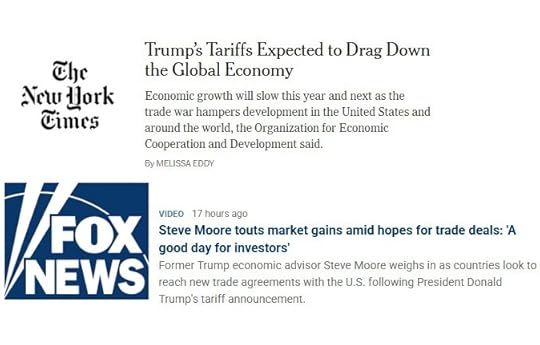 Two media outlets, living in two different worlds
Two media outlets, living in two different worlds–
So while Democrats and Republicans like to do battle over which media sources are biased, in reality they’re all wrong: all click-funded commercial media is biased – sometimes politically but even more importantly biased towards generating outrage and fear, because those generate more money.
There are two solutions to this:
1) Either ignore the media completely and focus on your own life, or
2) Become a subject matter expert on things you really care about, and then read the original sources whenever you want to learn about something.
I mostly practice option #1, but as a science and technology nerd I get into #2 in just the areas I find most interesting. And it’s amazing how the more deeply you understand a subject, the more you see just how wrong most media stories are about your area of expertise. Which means they’re probably pretty wrong about almost everything.
So as always, with this lesson learned it’s time to shut down that phone and laptop, exhale all our worries and get back outside with your real-life family and friends. See you in a few months!
Related:
Why We Are Not Really All Doomed – the original all-purpose MMM article which explains why we never really have to worry about the long-term economic future.
February 25, 2025
Wow, have you seen the stock market lately?

 –
–And by lately, I mean the past several years or more.
The value of the S&P 500 index of stocks, where most of us hopefully have a good chunk of our retirement savings stashed into index funds, is up about fifty seven percent in just the past two years. And it has more than doubled in the past five.
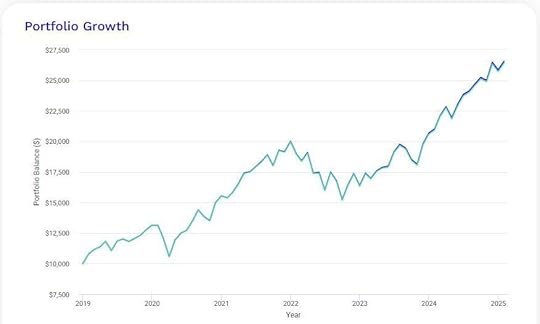 S&P returns (including dividends) since 2019, graph by the excellent portfolio visualizer website.
S&P returns (including dividends) since 2019, graph by the excellent portfolio visualizer website.This means that on a net worth basis, if you felt like you were only halfway to retirement as recently as the Covid Era, you may have suddenly blown right past the finish line. And some of us who were already retired long before that, may find ourselves eyeing up expensive properties or engaging in other money-burning-a-hole-in-our-pocket behaviors.
Is this real? Or is it all a bubble or some other sort of financial illusion?
As one reader recently asked me in an email:
“The market seems to be in a huge bubble right now due to all sorts of hype around Artificial Intelligence. Does this make it more vulnerable to a huge crash in the future, and will it affect my retirement?”
To answer this question, let’s take a closer look at our current somewhat unprecedented financial world and stock market. And to understand that properly, it helps to go back to the roots of what a stock is:
A stock is a magical business arrangement which is really just a much more convenient version of a rental house.
When you own a rental house, you are entitled to collect rent. After you cover all the expenses related to the house, you get to keep the rest, and this amount is your profit.
If the average sale price of rental houses in your area goes up but the tenant keeps paying you the same amount forever, it may look good on paper but it doesn’t really mean anything unless you sell the house. And then you’d just have to turn around and pay that same higher amount for a different rental house.
Your paycheck remains unchanged unless you can make your little house rental business more profitable. So you might squeeze in a basement apartment, do some renovations, streamline expenses, or do other things to increase your net earnings.
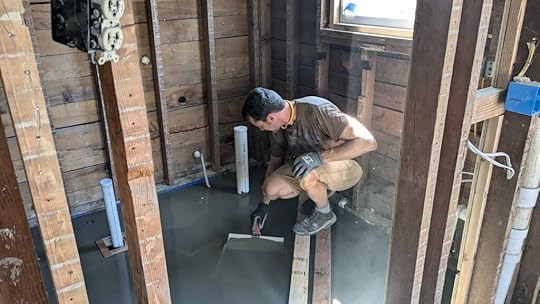 –
–When you eventually sell that house to another investor, the price they are willing to pay should be based on that future stream of income.
For example, if the house brings in $2000 per month ($24,000 each year) and the sale price is $240,000, the next investor is buying a business with a price-to-earnings ratio of 10, because 240k/24k=10.
But if you manage to convince someone to hand over $480,000 for that same house, you’ve sold at a P/E of 20. This is a much better deal for you as the seller, but quite obviously a less rosy future for the investor buying it.
Now back to the stock market. If you put $100,000 in the market in 2019 and reinvested the dividends, today you’d already have an astonishing $256,960 (a 157% gain on your original investment)
But in that same time period, your share of company earnings from that $100,000 basket of stocks has only gone from $5290 to $7540 (a measly 42% gain) – information you can get from handy analysis sites like multpl.com
In other words, the Price-to-earnings ratio has risen from about 20 back then, to about 30 today.
So as stock investors here in 2025, we’re just like rental house investors finding that house prices have more than doubled while rents are only up by a bit. Which makes the landlord business a lot less profitable, and we should expect exactly the same thing as stock investor: lower future profits as a percentage of our portfolio value.
That doesn’t mean it’s unprofitable to own either one of these things – stocks or rental houses. But it does mean that we should expect our future income from buying them at today’s higher price-to-earnings ratio should be lower than if we could get them on sale. It’s just basic math.
But Wait! What if the Earnings are Rising?
Let’s say you’re considering a rental house which is a bit overpriced based on today’s rent, but you happen to know that a big Apple campus is about to get built right nearby. At that point, you expect that rent will start climbing rapidly for many years to come. In this situation, you should be willing to pay more for those future earnings when you buy the house.
This is exactly why the price of an individual company’s stock will tend to rise when some good news comes out about the company. During the Covid era, people started buying more Peloton bikes so they could exercise at home, and investors (foolishly) believed this would be a permanent trend. So Peloton stock went way up. Later, reality sunk in that this was just a fad and Peloton sales returned back to normal levels, and so did the stock.
But what does it mean when the entire market goes up to much higher levels? Does it mean our entire economy is expected to grow much more quickly?
In the case of the current stock market euphoria, not exactly. Because if you dig into the share prices of the 500 big companies that make up our famous S&P 500 index, it turns out that almost all the recent growth – about three quarters of it – came from just the seven biggest companies, known as the Magnificent Seven: Apple, Nvidia, Microsoft, Amazon, Google, Facebook, and sometimes Tesla.
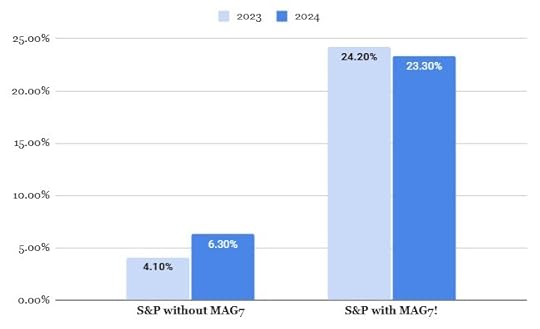 The real cause behind our raging bull market
The real cause behind our raging bull marketThese are all high-flying, super profitable tech companies who have seen a lot of growth and hype recently, which has caused investors to get excited and bid up their share prices in hopes of even more future growth. Collectively, they make up over 25% of the entire market value ($17.66 trillion!) and have much more expensive P/E ratios than the rest of the market (a weighted average of about 45)
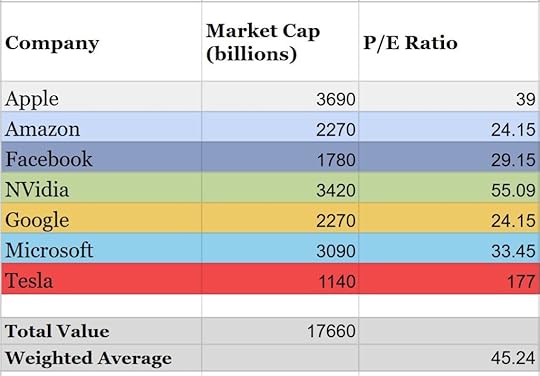 The MAG7 companies are expensive, especially Tesla which trades on the hype of possible future earnings rather than current profits.
The MAG7 companies are expensive, especially Tesla which trades on the hype of possible future earnings rather than current profits. If you exclude these seven biggest companies and just consider the remaining 493, you will find a P/E of only 20, which is more reasonable although still much higher than average.
What this tells us is that while investors expect the overall US economy to be fairly healthy in the coming years, they expect the biggest tech companies to continue to enjoy much faster growth.
What Does This Have To Do With Artificial Intelligence?
There’s one common theme in the big tech company boom right now: recent advances in AI have surprised the business world as software is suddenly able to display human-like reasoning in a rapidly growing number of fields. And because of this, the entire business world is fired up into a frenzy.
Six of those Magnificent Seven companies are spending hundreds of billions of dollars to build preposterously large warehouses full of supercomputers, and the lucky seventh (NVidia) is on the receiving end of those billions since they make the supercomputers and the incredible demand allows charge insane prices while still shipping them out by the trainload.
But that’s just the first level of this boom, the AI Infrastructure. As you move down the chain, every other industry hopes we have entered a new era of productivity and thus profits will grow faster than ever.
They may actually be right: You can now do things like feed in an entire novel or legal document or piece of code and ask the AI to answer detailed questions about the characters, or identify loopholes in the contract, or even find and fix bugs for you. AI can also drive cars, identify melanoma from photographs of your skin, design medications thousands of times better than what we’re used to, and even bring humanoid robot bodies to life as mechanical workers.
The idea is that we’re on the verge of having an infinite workforce of highly intelligent AI employees who will work for us for free, eliminating the biggest constraint that humanity has had in the past: a finite supply of both intelligence and labor.
Having followed the field in some detail for a while, I personally think all this will come true, although the timeline is uncertain. And the people bidding the share prices up to these levels obviously believe it too.
But the question is, will the profits of these companies really come through at the levels they forecast? Or will there be surprises down the road: cost overruns, competition, or unexpected disasters as these newly smarter-than-us computers decide that they no longer want to be bossed around?
And what if we end up with massive unemployment and resulting social upheaval if this amazing technology puts us all out of work, leaving only Sam Altman atop his personal mountain of $100 trillion dollars taunting the world forevermore with an annoyingly quiet monotone cackle?
 Image generated by AI… of course
Image generated by AI… of courseThere’s Only One Real Answer: Nobody Really Knows!
While the future is unknown, it can still be useful to use the past as a guide. After all, if you look at the history of US economic growth over time, it averages out to a surprisingly steady figure, decade after decade: about 3% after inflation.
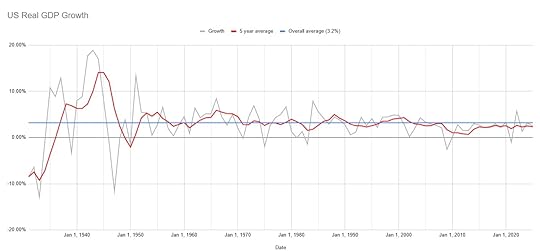 How our GDP grows: even as the world changes drastically, growth remains remarkably stable over the decades
How our GDP grows: even as the world changes drastically, growth remains remarkably stable over the decadesOne thing I noticed when making this graph: recent decades have actually seen slower than average growth, which is even less reason for the stock market to be priced the way it is.
So What Does it all Mean? Should We Do Anything About It?
As I said earlier, it’s still going to be profitable to own stocks for the long run, just a bit less profitable than those times when we got to buy our stocks on sale. Of course, there will be occasional manias and panics and crashes. But as always, it will be a losing game to try to time them – for example by selling all your stocks now and hoping to buy them at a cheaper price at some point in the future.
And over the long run, even if stocks return to more typical valuations, the end result would be something like the yellow line in this graph:
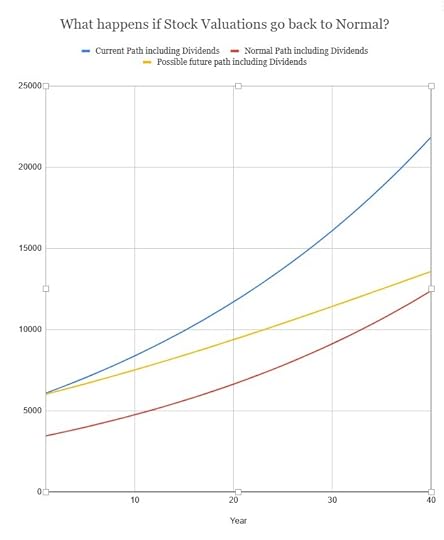 While the Blue path would be great, Yellow would be fine too
While the Blue path would be great, Yellow would be fine tooOur economy will continue to grow and company earnings will grow along with it, but future investors might choose to pay a lower multiple for those earnings.
Just like when you eventually sell that rental house, you shouldn’t expect someone to pay you a million dollars for a place that only brings in $3000 of rent.
Final Thoughts And Alternative Strategies
Everything we’ve covered so far is talking about the entire US stock market as a whole. And that’s what I usually focus on most because I still think this country is a uniquely good place to run a business. But what about other investing options? It’s always fun to at least look around and understand the larger investing world.
For starters, there’s Vanguard itself, the bedrock of the index fund world. Every year they gaze out at the investing horizon and make a ten-year forecast (guess) at future returns. This year they came up with these numbers:
Vanguard’s updated 10-year annualized return projections:
Global bonds, non-U.S.: 4.3% – 5.3%U.S. bonds: 4.3% – 5.3%Global equities (ex-U.S., developed): 7.3% – 9.3%Global equities (emerging): 5.2% – 7.2%U.S. equities: 2.8% – 4.8%Wow look at that. Vanguard is forecasting that International stocks of all kinds and even bonds will outperform US stocks in the coming decade.
On the surface, this makes sense because the P/E ratio of the international stocks (for example the VXUS fund) is only 15.9, meaning those European stocks are on sale at almost 50% off compared to ours!
Just one note of caution however: Vanguard has been making this same prediction for several years and just been wrong so far. Part of the reason is that most of the AI boom seems to be happening in the US.
The Betterment Portfolio
Longtime readers know that I’ve had a growing portion of my investments in a Betterment (robo-advisor) account over the past eleven years (see the ongoing report here). I decided to try this for precisely the reasoning above: by allocating money across more categories than just US stocks and automatically rebalancing, we should be able to see slightly higher returns with slightly lower volatility, and some tax advantages as well.
So far, my experiment has drawn some heat because in retrospect, a US-only portfolio has outperformed any other option over this time period. The Betterment portfolio comes close, but the exposure to bonds and businesses in other countries has held it back, just as you’d expect. But if you believe that things will eventually balance out again in the coming decades as the Vanguard analysis suggests above, it still has a chance to catch up.
Looking at my investments there, you can review the betterment core portfolio and calculate that the weighted average of all those holdings gives us a P/E ratio of about 22.
What Does Warren Buffett Say?
It’s always worth checking in with The Oracle on matters of the economy while we’ve still got this wonderful old sage around (see this year’s Berkshire Hathaway Shareholder letter if you want some further deep reading). And Warren is signaling that things are overvalued and bargains are few and far between. So Berkshire is holding $334 billion of uninvested cash for now, not even repurchasing its own shares which it considers slightly overvalued at the current P/E ratio which averages out to about 21 in recent years.
What About Paying Off Your House?
Over the long run, you usually do better if you keep a mortgage on your house and pay it off slowly, while directing all the surplus cash into index funds. But there is some point at which the opposing factors of lower expected stock returns and higher interest rates meet in the middle and this situation flips.
If you have a 7% mortgage right now, it might be a fairly close tradeoff at this point. But the real factor is how you feel about paying off your house. I happen to love being mortgage-free so I paid off my last mortgage over ten years ago and have never looked back.
Another way to think of this is that paying off your house is like buying a 7% bond. Definitely one of the best guaranteed returns around, and much more sensible than leaving tens of thousands of dollars in a checking or savings account unless you have a clear use for that cash.
The Final Word
If you’ve read any of my stock investing articles before, you’ll know that we always end up at the same place: Just relax, enjoy your life, keep investing, ignore the daily news headlines* and don’t worry.
 –
–Then reinvest that time that everyone else spends worrying into enjoying more time engaged in hard physical stuff in the great outdoors. That’s the only place where you’ll get guaranteed market-beating returns, every time.
 –
–In the Comments: what are your thoughts on the current stock market boom, future crashes and busts, and the role of Artificial Intelligence in our future?
All the other MMM Stock Market Articles from past years:
Finally, a Stock Market Crash!What to Do About This Scary Stock MarketHow About that Stock Market!?Houses and Stocks are Going Up – Who Cares?How to tell when the Stock Market is on SaleSummer Clearance Sale on US Stocks!*although in my opinion it’s okay to check in weekly with The Economist, which has been my favorite source of world economic news for 32 years and counting.
January 16, 2025
Retired Man Tries to Spend More Money, Mostly Fails

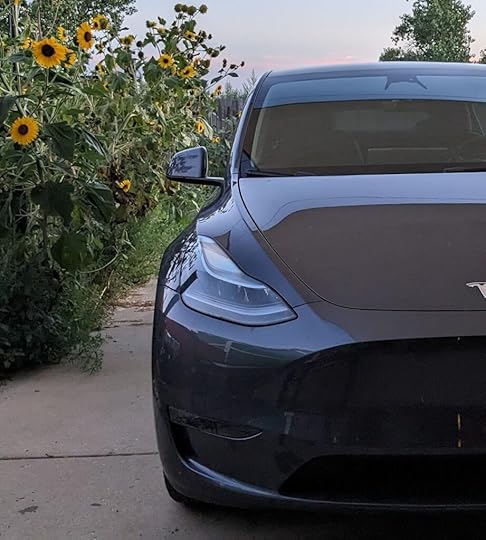 –
–A couple of years ago, Mr. Money Mustache lost some credibility among the faithful when he wrote this blog post about actually trying to spend a bit more money, while buying a Tesla as the first step in that program.
“Look at me!”,
I thought to myself at the time,
“I’m such an enlightened middle-aged Badass, adjusting habits and realigning myself at the snap of my fingers. Onward to the next forty eight years of the Good Life!”
So, two years passed with an even greater feeling of abundance. I had a marvelous time traveling everywhere and spending money like I thought a proper wealthy person would do.
I dined out in stylish restaurants, booked hotels based on their niceness rather than their cheapness, paid extra to sit in the “reduced torture” seats of the airplanes, and gave zero fucks about paying double for groceries if I happened to be in a Whole Foods rather than my usual Sam’s Club and Costco (and yes I treat myself to memberships at both warehouse stores!)
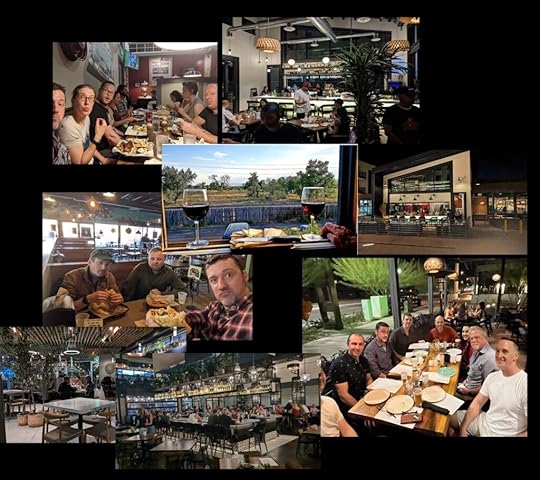 –
–Among the highlights, my son and I have worked our way though a nice selection of late night EDM concerts and three Meowwolf art venues including a Christmas Day road trip from our winter home in Tempe Arizona to Las Vegas last year. And having spent much of the year as a single man, I had a wide open schedule to just meet up with friends, explore new places and meet new people as opportunities came up. It felt like a year of adventurous transition, which means it felt like much more than twelve months.
 –
–With all this flashy spending, I was sure my budget must have crept back into full American Consumer territory. But I was having too much fun to bother adding it all up to check.
Until recently, when I was doing another round of informal coaching for a friend and we both decided to tally our spending for the past year to compare notes.
When I finally finished sorting all of those transactions into a spreadsheet and hit the “sum” button, the results surprised me.
While my overall spending had indeed increased (especially in travel-related categories), the big-picture effect was still pretty minimal. Depending on how I account for things like the car and my business expenses, my spending went from $20,000 to about $30,000 (plus the usual hidden subsidy of a paid-off house.)
This level could still be sustained by a $1 million investment nest egg. Since my investments are quite a bit higher than that (especially after these recent years of crazy economic growth and the never-ending stock market rally), I’m still way under budget.
Although I still “failed” to really increase my spending to the MMM-recommended levels for old wealthy people, this still makes me happy, because I have genuinely had more fun with the abundance mindset, and I can keep trying more life experiments in the coming years.
As we covered in the 2019 article on the idea of an Optimization Council, it’s always a good idea to compare our spending, tips and tricks on how to get the most out of life. Almost twenty years into early retirement, this is where I have landed so far, although I’m always learning and open to feedback.
Anyway, let’s cut the wistful commentary and get into the budget.
CategoryFrom Personal CardFrom Business CardTotalDetailsGroceries$5,465.56$494.83$5,960.39For me + young adult son about half the time + guestsRestaurants$2,145.11$98.48$2,243.59Restaurants only for special fun rather than just getting foodTravel$3,982.00$2,176.77$6,158.77Business travel is for things like Camp Fi and other fun conferencesUtilities$1,909.510$1,909.51Amazon/House$949.64$2,604.46$3,... 75% of business is actually construction materials for clients (usually friends) which were reimbursed via invoiceBooze$250.670$250.67Wine and other beverages for entertaining.Healthcare$813.20$2,723.46$3,536.66This is cheap thanks to Sedera Health Sharing plus a Direct primary care (DPC subscription)Also paid for some advanced blood tests just for screening and learning purposes.Automobile$2,191.68$233.53$2,425.21This is just car insurance and registration. We could add a “depreciation” figure in here to be more accurate. Phone+Internet$1,410.561410.56$50 Gigabit Internet (!) and about $25-30 for my monthly for Google Fi bill + taxProperty Taxes$2,577.30$2,577.30Surprisingly reasonable given the $500-600k value of houses in my neighborhood.Total$20,284.67$9,742.09$30,026.76–
In summary: Wow, how interesting! When we compare this to my 2019 post on that year’s spending, it’s only a bit higher even after all the inflation we have seen in recent years. I spent more on travel and fun, but less on home renovation – partly because I was away so much I didn’t have as much time to work on my house. The health insurance is a new cost too since I was self-insured back then.
The Biggest Savings:
My budget is notably missing the biggest expense for most people, which is housing costs. This is because I paid off my house long ago, and I also love working on and taking care of my own home, which means there are no bills for lawn mowing, plumbers, tree pruning or handyman services.
This strategy is not for everyone, and it’s not even the optimum financial one for me – I would have been better off taking out the biggest mortgage I could get at 3% back in the sweet borrowing times of 2021, and putting all that principal to work in stock index funds where it would have almost doubled since then. But I still get a great peace of mind from just having no mortgage payment, and there’s really no better way to use your money than to buy such good feelings. Also, I get a secondary benefit of not having to buy house insurance, which saves me another $2000 per year, boosting my effective return on that payoff.
What about Health Insurance?
First of all, the biggest money saving factor of good health and good luck has continued, meaning I’ve still had no actual medical expenses. But I still do maintain two layers of health care support which together feel very much like the ultimate version of health insurance: a membership with a top of the line Direct Primary Care (DPC) medical clinic ($107 per month) plus a high-deductible plan ($201) with a health sharing organization called Sedera.
The combined cost of $308 per month is less than the cheapest Bronze plan in the field of standard health insurance, yet I get personalized support with zero deductible for almost all typical medical needs, plus some protection from larger medical bills if my good luck runs out.
But as a disclaimer, I’m not an expert on medical needs and health insurance because I’ve had so little experience with the system. And the highest priority in my life is arranging my days for maximum health to give me the best chance of keeping it this way.
How could I do better?
When it comes down to it, money is a tool for survival and if we’re lucky, self actualization. So I’m always asking myself if there’s anything I can change or improve to make the most of this good fortune.
I also try to keep in mind an interesting principle of happiness, which says that,
Fixing your persistent problems is more effective than just doubling down on things that are already good in your life.
For me, there are already a lot of good things which don’t need improving. My family, friends, relationships, health, food and daily activities are pretty much as good as I could imagine.
The only annoyance I can think of is physical chaos: I have a lot of space-intensive hobbies like construction and music, and I currently live in a pretty small house which is basically maxed out. I could really use a doubling of my workshop space from the current 2-car, 440 square foot garage to maybe a thousand or so.
But I also love where I live and wouldn’t want to give up my views, neighbors or current place. So I’ll keep optimizing what I’ve got unless some perfect opportunity comes up for a bigger place right on my block.
 My future “Friends Mountain Resort” is just an AI generated image…. for now!
My future “Friends Mountain Resort” is just an AI generated image…. for now!In the longer run, a mountain compound with its own cliffs and stream are also on my “maybe” list. But once again, my days and life are already overbooked with joyful things. My existing house and our HQ Coworking space already have long to-do lists. Would I actually be happier if I added another place to my portfolio? So I keep this idea on the shelf until I’m willing to trade it for another existing commitment – like selling my house or the coworking space.
But for now, I’m just extremely excited to blaze into 2025 with loads abundance and piles of challenging stuff on my to-do list. And I wish you the same!
In the Comments: Where are you at on this spectrum of stinginess versus abundance mentality, and fulfilment versus longing in life?
A Temporary Note about Teslas and other electric cars:
Rumor has it that the $7500 EV tax credit might be disappearing when our new president takes over next week, so this might be the cheapest chance to buy what I feel are the best cars on the market: The Model Y, or Model 3.
Both used and new prices are at record lows so shop around and get an additional $1000 off a new one if you use a referral code from a friend or here’s mine if you need one (many thanks!)
Full article here at The Model Y Experiment.
FTC Compliance Note: I use referral links for some products when possible which means the blog may earn a commission if you use them. More details here.
October 13, 2024
Six Dumb Misconceptions About The Economy (that the Politicians Want You To Believe)

 –
–Well, it looks like we’re here in another US election year already.
As Advanced Mustachians, we already know that the ongoing battle of Harris vs. Trump should not be consuming much of our time. Sure, we do our research and cast our votes but after that we move right on to focus on other things within our own circle of control.
But out of all the things the politicians like to bicker about, there’s one area where MMM does need to set the record straight, and that area is of course money. Your money, the economy in general, and the overall wealth of the nation.
Politicians are already not known for being the sharpest tools in the shed when it comes to technical stuff like science, technology, or economics. But this year the discourse has become particularly dumb, as our candidates try to manipulate undecided voters in swing states with ideas that are based on irrational emotions rather than sound economic sense.
For one particularly funny example, you may have noticed that the competing party (Trump in this case) is attacking the incumbents (Biden/Harris) over the “bad economy.” When in fact the US economy is stronger than it has ever been, with the lowest unemployment we’ve ever seen as well.
It’s hard to imagine a better situation than we have right now, and in fact the recent bout of higher inflation is a sign that things have been going too well, and we needed to step on the brakes with the help of higher interest rates.
But somehow the people still seem to believe that we have a “bad” economy. Take a look at this Gallup poll showing that while most people (85%) are doing really well right now, they assume that it’s just their own good fortune – only 17% believe the economy is doing well.
This is mathematically impossible, because if most people are doing well, that’s the definition of a good economy! And suspiciously enough, this widespread wrongness correlates quite nicely with the rise of social media misinformation.
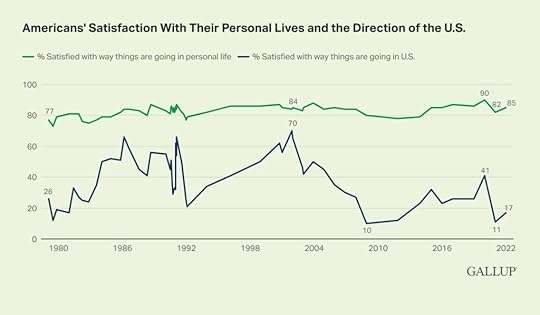 –
–So the politicians and the news have been doing the opposite of what they should be doing in an ideal situation (sharing accurate information). And sure, we can always just ignore their speeches and go on with our lives. But when it comes to economics, knowledge is power (and money). The more accurately we understand how things really work, the wealthier we will all become.
So with all that in mind, I hereby present you with my list of the…
Top Dumb Things Politicians Want You To Believe About The Economy
1: The President Controls the Economy
If there’s a recession, the opposition party likes to blame it on the current president. If the economy is booming, the current president likes to give himself (or possibly soon herself) credit for all of that success. But really, the US economy is way too big – and thankfully way too free – for the president to control or really even influence all that strongly.
In reality, our economy is a gigantic machine which converts labor and materials into things like iPhones, hospitals and pumpkin pies. And although we’re the biggest economy at 26% of the planet, we are still heavily influenced by that much bigger 74% of economic activity that the other 7.6 billion people on Earth are busy producing everywhere else.
When we have our inevitable little boom and bust cycles, they are mostly caused by the normal cycle of irrational exuberance (and greed) like the 2007 housing boom, followed by brief periods of extreme fear and pessimism like the 2008-2012 financial and housing crash.
The government does play a role too, by setting tax rates and other rules. But the effects of these policies are usually so delayed and unpredictable, that you can’t draw a straight line between today’s president and today’s economy. In other words, the government does its best to adjust the rudder on our giant ship, but in the short term our economy lurches around on the waves and storms of the ocean.
2: The President Controls Interest Rates
This one is especially funny to me, as our candidates feign sympathy for the hard life of middle class Americans, who now face higher borrowing costs on their credit cards and car loans and mortgages. They claim they will fight to bring the interest rates down. Trump even goes as far as bullying our Federal Reserve board members (who can only do their jobs if we allow them to function as independent experts) and suggesting that he would take over the whole department, if elected.
The real story is that while monetary policy would be a terrible tool to leave in the hands of a sitting president (see Argentina), it does function as an excellent set of gas and brake pedals for the economy if used properly. When things slow down and unemployment gets too high, a cut to the interest rates will produce a boost in everything from new jobs to stock prices. But if things get too hot, you get rapid inflation which can mess up the system.
3: Inflation has Made Life Harder for Americans (and the President Can Magically Reverse it)
This line of reasoning is even dumber than the last one. For a couple of years after the Covid era, we had rapid inflation. It was caused by a rare combination of a goods shortage caused by things like factory closures and remote work, plentiful demand from government stimulus spending and low interest rates. These factors have since ironed themselves out, and inflation is back down to an ultra-low 2.4%.
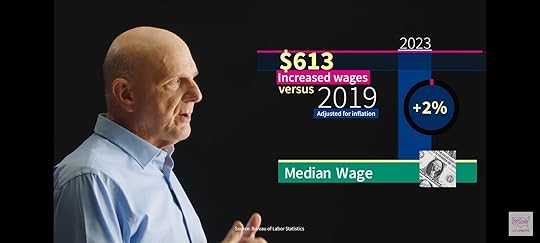 Steve Ballmer explains the inflation vs wages debate in his useful new video series called USA Facts (see note below)
Steve Ballmer explains the inflation vs wages debate in his useful new video series called USA Facts (see note below)But most significantly, wages have still risen faster than inflation so we are all better off than before! Since 2019, overall prices are up 19% and our wages are up 21%. So even after all that inflation, we are still doing just fine. But the candidates are still bickering over inflation as if it’s an actual problem, and even worse promising to “bring prices back down”. And they’ve managed to convince the electorate that “higher wages and prices” is the same thing as “a bad economy”. Which is just plain wrong.
Bonus dumbness: politicians also occasionally blame “greedy corporations” for increasing prices to hoard profits. While price increases are totally acceptable in a market system (as a business owner you are free to set prices wherever you like), in reality it doesn’t usually happen because our markets are too competitive. For example, a recent deep analysis from NPR showed that no, grocery stores haven’t made any windfall profit at all off of this recent bout of Covid-fueled inflation.
4: The President Controls Housing Prices
One important thing that has changed over the past ten years is that US house prices and rents have both risen much faster than general inflation and even wages. On the positive side, interest rates have also risen which tends to make houses feel more expensive and is supposed to help bring house prices down. But it hasn’t happened yet which means we have the double whammy of higher prices and higher interest costs for mortgage borrowers.
The dumb part is that our candidates are proposing things that would make the problem even worse, like subsidies for first-time homebuyers or schemes to reduce the interest rates. When really the solution is to increase the supply of housing, which I personally think will happen if we stop putting up roadblocks for homebuilders (myself included) to build housing.
Things like faster and cheaper permits, less onerous and expensive building codes, eliminating suburban-style zoning and setback and car parking rules, and changing laws so that NIMBYs no longer get any say over what other people do with their own land could all help reduce the cost of building a house by about 50%, quickly and permanently.
5: The President Controls Gas Prices, and They Are Currently “High” and We Want Them Lower
Ahh, gasoline! The most ridiculous of things to worry about and the fuel for many of MMM’s rants since 2011.
First of all, on an inflation-adjusted basis, gasoline is still about the same price as it was in 1950: in the $3-4 range per gallon, in today’s dollars.
Secondly, it is so cheap that even with our huge inefficient American vehicles, the average household is still only spending 2.5% of their disposable income on the stuff! (The funny part is that they spend many times more on the rest of the car ownership experience while thinking gas is the part that is expensive)
Third, gasoline has been obsolete for almost a decade now. You can get a used electric car for less than the price of a comparable used gas car, or if you’re a fancypants money waster like me, new EVs are also cheaper than their gas counterparts. You get a faster, nicer car that almost never needs maintenance OR gasoline, and save money.
So why are we even still talking about this antique fuel of a previous era? Why aren’t the candidates also arguing over the price of Kodak film or typewriters or fax machines?
6: The Economy is Something We Should Even Worry About
The funniest part about all this economic talk is that we’re focusing on the wrong thing. While hard work and business and advancing the frontiers of human knowledge are all fun things, the reality is that we passed the point of having “Enough” decades ago. When the American middle class complains about how hard we have it these days, it’s like a bunch of overfed people at a buffet wishing they could just have one more flavor of donuts stacked onto the table.
Yes, we have income and wealth inequality so that the rich tend to get richer more quickly. And yes, we should keep that in check with a somewhat progressive tax system because a more equal society tends to be a more peaceful and happy one.
But have you noticed that as the rich people get richer, they don’t get any happier? It’s because after you pass the point of “Enough”, adding more money doesn’t really help much.
And “Enough” is much more defined by your mindset (and your collection of life skills) than your paycheck. So if the politicians really cared about improving our happiness and wellbeing, they’d be preaching the Principles of Mustachianism rather than pandering to the specific requests of coal miners or billionaires.
But alas, winning an election is a very different thing than proposing stuff that is actually best for the country. And for that reason, we cast our votes for the best party and then tune back out until the next election.
Happy voting!
In the Comments: Has the election season been getting you down, pumping you up, or just giving you a thorough dose of “Meh”?
Further Reading/Watching:
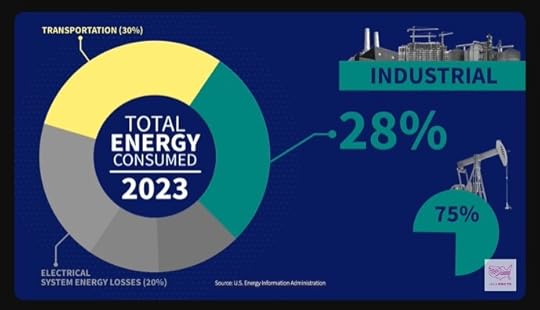
While researching economic stats for this article, I came across a quirky but informative series of videos called USA Facts by none other than Microsoft co-founder Steve Ballmer. It seems that he had the same frustration as me: Americans are fighting over a bunch of opinions and misinformation without even bothering to look up the actual facts. So he made a well-produced series of videos that just share the facts without the baggage of political hype on top of them. I wish our politicians could do the same thing!
Bonus Podcast based on this article!
Thanks to the magic of AI, you can direct the wizardry within Google to generate a custom-made podcast on almost anything on the Internet. A reader just emailed me this take on this episode – remarkably human-like and even entertaining!
https://notebooklm.google.com/notebook/0e1d0af8-8888-466c-abe4-8b1da8986773/audio
July 23, 2024
$656,000 of Frugal Things I Still Love Doing
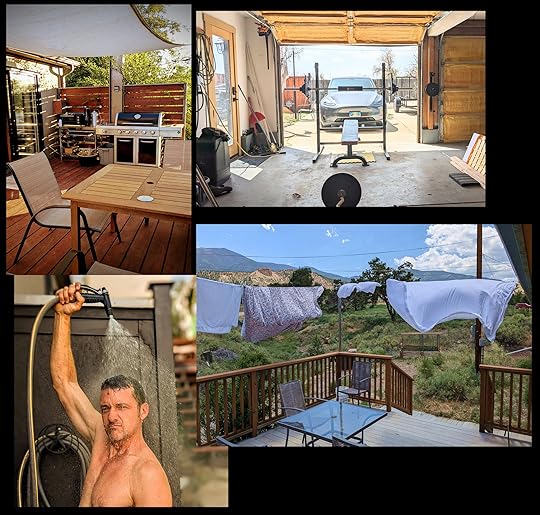
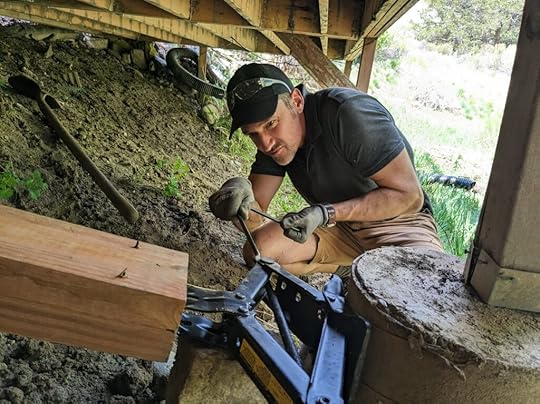 –
–“I used to read Mr. Money Mustache”,
some people say these days,
“Until he got all rich and fancy so that he no longer understands the common person’s plight.
Stash probably doesn’t even practice any of these money-saving things he preaches any more!”
When I read things like this, I can’t help but laugh. Because on the one hand, when you put a bunch of personal life details online like this, being misunderstood is just part of the package. But on the other hand, if the critics could peek in and see our real lives – not just mine but those of all the Mustachians – they would have to give up their conspiracy theories and accept the fact that this stuff just works.
Because really, not much has changed when it comes to the basics. Like many MMM readers over the past twelve years, my total wealth level has increased pretty regularly. But also like many of us, I haven’t felt the need to change very much about my spending because I was doing my best to live an enjoyable life in the first place.
How have so many people found such great success? I think we Mustachians have something that’s a bit more rare and special than standard financial advice, which is what makes it work so well:
Standard Advice:
Slash your spending and make sacrifices until you reach a certain savings percentage, and beyond that it doesn’t matter, it’s all personal choice. More income? Great, that means you don’t have to sacrifice as much! FatFIRE for everyone!
Mustachianism:
Cultivate a love of efficiency, creativity, self awareness, and self improvement. Use this knowledge to improve your life in all ways, including those which help you live better even as your monthly expense rate drops over time.
So what does this mean in practice?
Well, I’ll give you some examples from my own present-day life. Things I do because I happen to enjoy them, which also happen to save a lot of money. Some of these are normal, some are silly and may end up in some future gossip magazine hit piece, but all of them happen to work for me, so the critics can be damned.
As I list each item, I’ll include an estimate of how much the activity saves me per decade, because you should always think at least in terms of decades.
To make that calculation yourself, just use the “rule of 172” – take a monthly expense and multiply it by 172 to estimate how much it would compound into over ten years, if invested.
1) Fixing my own House (and everybody else’s too)
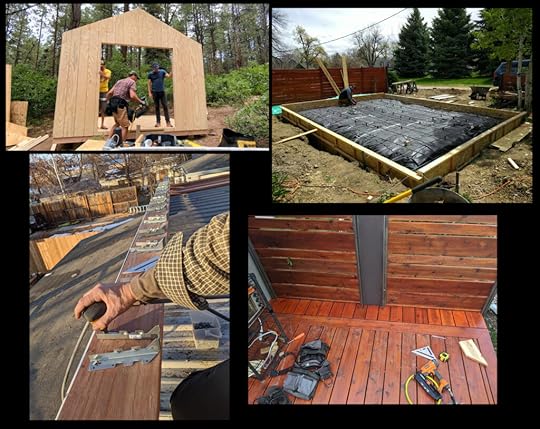 Construction projects from recent years, at home and around the state.
Construction projects from recent years, at home and around the state.I’m a big believer in self-sufficiency, and working to build up the skills to manage the most important parts of your own life without depending on too many things (or people) that are outside of your control. In other words, one giant recipe for a happy life is simply to Become a Producer of the Things You Most Enjoy Consuming.
And in my case, I happen to love houses. I like living in beautiful, functional spaces and sharing them with friends. But most houses are ugly and poorly designed when you buy them, so I realized that I also love solving problems and redesigning old buildings to become new again. I enjoy this process so much that I spend most of my free time doing it – on both my own properties and the homes of friends.
And I love teaching other people to gain power over their own houses too. It’s amazing how great people feel as they lose their fear and dependence on outside contractors, and gain the ability to fix and maintain things with their own two hands.
Savings: An average of $20,000 per year = $287,000 per decade
2) Craigslist and Community
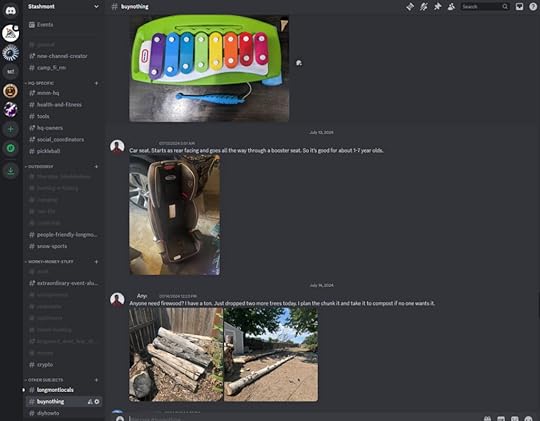 Members of our coworking space, swapping valuable free stuff every day.
Members of our coworking space, swapping valuable free stuff every day.You know what’s great? Having so much money that you can buy whatever you want – high quality things which get delivered to your front door the very next day.
You know what’s even better? Not buying some of those new things, and instead finding ways to share, repurpose and buy equally high quality items from other people who don’t need them any more. All while building up your own community and creating new friendships in the process.
Craigslist, Facebook Marketplace, and even NextDoor all have Buy Nothing groups for most areas. In the MMM-HQ community, we run a Discord server with about 200 local people, who chat around the clock on a wide range of subjects. They help each other with major projects in one channel called #diyhowto, and give away and sell things on #forsale and #buynothing.
Although our private Discord group is my favorite, I also use Craigslist regularly, and probably save (and earn) a few thousand every year thanks to the habit:
Savings: About $42,000 per decade
3) Bikes over Cars
 Sure glad I’m not stuck in a Jeep on these off-road trails!
Sure glad I’m not stuck in a Jeep on these off-road trails!We all know that Mr. Money Mustache’s biggest contribution to personal finance is to insist that bike transportation is the best way to get around. And I still feel this way. As we learned in The True Cost of Commuting, cars cost at least 50 cents per mile to operate, while bikes are much cheaper, mainly due to reduced depreciation and maintenance costs (which are even bigger than the gas savings).
I do still use bikes (or walking) for at least 95% of my local trips these days, but because I live in the center of a small city, my life is pretty local. So this still only adds up to about 2000 miles per year, a savings of “only” $14,000 per decade.
But when you choose active transportation, there’s much more to the picture than just cutting your car expenses. You’re changing everything about your physical and mental health picture for the better, which brings us to the next point of…
4) Muscle over Motor
 Digging out the crappy old window wells to build a bigger terraced garden.
Digging out the crappy old window wells to build a bigger terraced garden.Although I’m no competitive athlete, whenever I see an option to make my body work a bit harder, I usually take it. Stairs instead of elevators, running the golf course instead of using a golf cart, moving my own furniture and appliances instead of calling a mover, shoveling snow and raking leaves instead of using a machine.
When I face a decision like this, I simply ask myself the question:
“Well, Mustache. Do you want MORE health and fitness, or LESS?”
Putting it in that context makes the answer obvious. Every bit helps, because when it comes to your body, the rule is pretty much use it or lose it.
But how much money does this save? There’s no real way to calculate it exactly, but I like to think of it this way: The US average health care spending is about $13,000 per person per year. My lifetime costs due to illness or medication so far have been just about zero, plus I know I’ve had more energy and greater productivity due to being healthy. Let’s just put it very conservatively and set the estimated savings and benefits at $10k per year which means
Estimated Savings: $140,000 per decade.
5) Saving Energy by Running my home like a Glamping Retreat
 Outdoor cooking, showering, laundry and even a homemade gym? Why not?!
Outdoor cooking, showering, laundry and even a homemade gym? Why not?!Here’s where things get a bit silly, but my level of joy is actually at its greatest.
My personality type is probably a weird combination of an engineer, a carpenter, an artsy hippie, and a mad scientist. Oh, and a devoted homebody too. Because of this, my favorite activity most days is to just run around my house taking care of things and trying new little experiments and improvements.
Sometimes I’ll cut a few big holes on on the South side of the house and install sliding doors and big windows to allow nice sunbeams and passive solar energy to get into my house and give me free heat in the winters. Other times it’s just smaller things to save energy and live more at at one with the seasons of my area:
optimizing the use of air conditioning by running fans at night and building heat tolerance during the days (we set the A/C to only kick on at about 80F)Enjoying most of my showers outside, with free hot water from the 100 foot garden hose that happens to be coiled in a sunny spot
Cooling myself and get free energy boosts by jumping in the “cold plunge”, which is simply an unheated hot tub I have set up in my back yard
Doing most of my cooking and dining outdoors with an induction cooktop, gas grill, espresso machine, and mini convection toaster oven deal that I keep set up outside during the warmer months of the year
Drying 99% of my loads of laundry out on the line instead of using the clothes dryer
I even charge my car with a little off-grid array of solar panels set up in the driveway (from Craisglist, of course!), which gives me free electricity for driving without going through the permit-hell hassle of a full grid-tied system in my city’s currently solar unfriendly environment.
Even taken all together, these things are pretty small – the average combined gas and electric bill for my area is about $250 per month, while my usage adds up to about $75. So while we’re only saving about $30,000 per decade for what sounds like a lot of work to most people, I consider this to be the biggest win because I enjoy living in “MMM’s Energy Efficiency Playground” so much.
6) Local Living over Constant Travel
 This little lake right behind my house is a great daily “vacation” which allows me to savor home life more and travel a bit less.
This little lake right behind my house is a great daily “vacation” which allows me to savor home life more and travel a bit less.“Hey, we’re having a big back yard pool party next weekend to celebrate Amy’s graduation from kindergarten, can you make it?”
“OH NOOOO!!! We will be off in at Disneyland that whole week! We planned the trip months ago, I wish we could make it!
As I type this in the height of the summer season, I really feel this effect at its fullest: almost all of my friends are off on trips, and my guest suite here at home is almost constantly full. People are traveling a lot, and many of them sound like they wish they could spend a few more of their precious summer weeks and weekends at home.
I’ll let you in on a little secret: you can! The trick is saying, “no thanks” more often to plans that involve you being away, and “yes please” to things that let you stay at home. The benefits are numerous:
You nurture your local friendships more and meet new people who live nearbyYou spend way less money on plane tickets, hotels, restaurants gasoline, and car repairsYour levels of health and fitness can go way up because you aren’t missing workouts and spending hours sitting in plane and car and bus seats. And you can better control your meals – more salads with grilled salmon, less McDonald’s and Pizza Hut You sleep better And you have more time to take care of projects around your house where you learn more skills which compound for lifeEstimated Savings: Even if you replace just two weeks of travel for a family of four, with equivalent time at home you might save $5,000 per year in direct costs and a further $5,000 per year in incidental benefits like the health and local friendships. This would work out to a shocking $143,000 per decade of wealth increase!
Of course, travel is generally a good thing for broadening the life experience of you and your kids. It’s worth spending on, lavishly at times. But the key is to balance it out and be discerning, keeping the most enriching trips and pruning a few off the bottom of the list. And remembering that home time is valuable and healthy too.
And Whoa! We’ve already built up a huge list and I feel like I was just getting started.
 Cutting a friend’s hair at a group event: entertainment, education and free haircut in one!
Cutting a friend’s hair at a group event: entertainment, education and free haircut in one!Taken all together, we’ve already detailed things that compound to $656,000 every decade, which already more than double the median wealth that most American seniors have as they cruise nervously into their retirement years – after over 40 years of work!
And now that I’ve been writing this blog for over ten years myself, I can safely say that over $656,000 of even my most recent worth increases are directly attributable to these simple habits. The same ones many of us have been enjoying and preaching about all along, both before and after our retirement dates.
If money is in genuinely short supply, you could go a lot further than the examples in this article. And indeed, there’s a lot more laid out in this blog or the MMM Boot Camp email series.
But one of the points of Mustachianism is that you usually don’t have to try all that hard. Just tweaking your lifestyle to be slightly less ridiculous and more efficient than average is usually all it takes.
—
In the comments: what are your quirks and frugal indulgences? The things you do now to save money, or things you still do even after it’s no longer about the money? I often wonder how widespread this frugality-just-for-fun is. But since we Humans are a naturally curious and problem solving species in our natural state, I suspect there are many more of us out there.
May 18, 2024
The Ultimate Life Coach
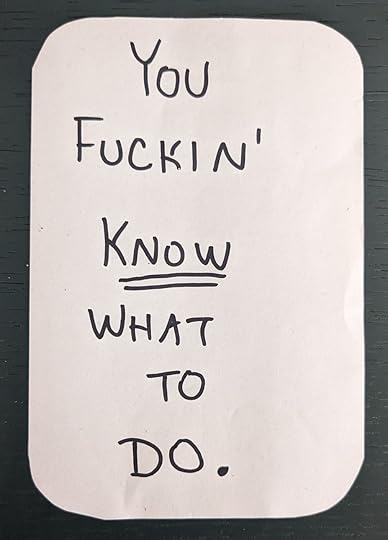
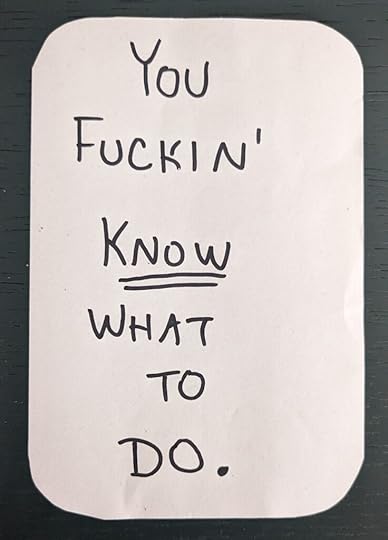 –
–Almost nineteen years into early retirement now, I’ve come to realize that the complete freedom of this lifestyle can be a double-edged sword.
You’ve already heard me raving plenty about the upside: having the freedom to raise a son from the day he was born to beyond his eighteenth birthday with no compromises. And then to put thousands of hours into everything else I value as well: family, health, friends, adventures, building stuff, and even writing the occasional blog post. No complaints about any of this.
But if I can indulge you to play me a brief Tiny Violin of First World Problems solo, even this perfect life comes with one flaw: I never have to do anything I don’t want to do.
To most people, this sounds like a dream come true. Especially if you combine total freedom with plenty of money, life is just a non-stop blissful playground of self actualization, right?
Well, maybe, but maybe not. In reality, the answer depends on who you are.
Freedom and money reveal a person’s true strengths and weaknesses, and the result is a spectrum with “Unlimited drugs and booze on the couch” at one end, and “Create and manage a series of nonprofit foundations which employ thousands of people to research and invest in medical advances and clean energy” at the other.
For most of my journey so far, I seem to have found the balance pretty naturally. My Dad job was very intense for the first decade, but somehow I also had time to build and restore quite a few houses in the neighborhood, take plenty of intense trips to interesting places, give some talks and make some videos, and still write a few hundred blog posts.
But in these last few years, I have started slowing down, and it has become more and more difficult to wrangle and focus myself to get these things to happen as often.
Instead of constantly bouncing around the construction site building cool things, or falling into laser focus on the keyboard finishing an article that I just had to share with you, I found myself retiring to the couch earlier and earlier each afternoon, seeking distraction on the phone and wishing I had the energy and focus to do those other more enjoyable things.
So I fought back, by learning more about health and wellness. Trying to study and train my way into more energy and focus and motivation. And you’ve seen some of the results here, in articles I’ve shared about daily habits, steering clear of excessive comfort, and more.
And all of these things really work, IF you take the knowledge and actually put it into action. And therein lies the problem:
I kept learning effective new things, and successfully incorporating them into my life. They would work for a while, but gradually my brain would invent various excuses to stop doing them consistently, leaving me with plenty of knowledge but far too little accomplishment to show for it.
Until finally, just a few months ago, I realized that I had been sabotaging my own progress by turning my biggest life advantage into a disadvantage:
I have been using my freedom too much – in order to avoid doing things that I didn’t feel like doing.
See, freedom is great if it frees you from leaving your children at 5am so you can drive an hour through a traffic jam to sit in an office building for nine hours. But that same freedom goes to waste if you then just plunk the kids down in front of a playlist of cheap cartoons while you lounge in the corner to scroll Facebook all day.
You need to use it to do things that are even more valuable than the job you just quit. And if you can’t do that, you might as well just keep the damned job.
This is what I was doing, while lying about it to myself. I would focus on the easy things which are still good for me, like taking care of the house or hanging out with friends who live nearby. But I avoid doing the harder things – which for me means the things that require more planning, energy or focus. Even though these are the things that allow me to lead the life I enjoy most.
Let’s use workouts as an easy example. I already know that on a minute-for-minute basis, this is the single most effective thing almost anybody can do with their time because it drastically improves every other area of life. But despite knowing this, I was still following this pattern:
“I want to get in a really good weight training workout today.
But I don’t feel like doing a workout because it’s hard.
So I’ll try to grease the wheels for myself so it’s easier to achieve.
I’ll pick the perfect time of day when the weather is nice, and my energy level is high.
I’ll set up my gym in advance the night before.
And when that golden moment of perfect conditions hits,
I’ll hit the gym!“
But between you and me, that moment didn’t always come. Some weeks I’d achieve it 2-3 times, some weeks I’d get “busy” and make excuses like “well at least I walked a lot today”. Some days I would complete a great workout, but when recording it in the journal I’d see that the previous one was over a week ago.
And the results of this lackluster effort were exactly what you’d expect: lackluster fitness.
Then something changed and I learned that there’s a much better way to get those workouts done. It’s by replacing the long, meandering, frankly wussypants dialog above with this one:
I want to work out today.
I don’t feel like it.
^^^ AHA!! I JUST CAUGHT MYSELF TRYING TO SELF SABOTAGE! ^^^
I am now already putting on my shoes and walking to the gym.
I’m using workouts as an example because this is the behavior I managed to change most successfully, but the exact same technique applies to everything else that you or I want to do, but fail to do regularly.
The key is learning to watch over yourself like an Eagle and identify that exact moment of hesitation.
And then instead of using it as a trigger for excuses, you use it as a trigger for action.
It’s so counterintuitive at first, but then obvious in retrospect. Hesitance feels shitty in the moment, and it really can ruin your life if you listen to it too often. But the ultimate solution is usually to run directly towards, rather than away from, the stuff you don’t want to do.
So really, Hesitation can be the ultimate life coach.
Using Extremely Badass People as Fuel
As part of writing this article, I shared the idea around with friends to test it out first. And I was initially surprised to get mixed results. About half of them could relate with me: they felt they were underachieving in life and wanted to do more. The other half though I was crazy: these people feel they are already doing too much, raising multiple kids and managing multiple businesses and training for ironman triathlons in the mountains.
The overachievers go through life nicely buzzed but often stressed. When hearing them describe their schedules, I was absolutely not envious. At the same time, they weren’t impressed with my schedule either because it’s too easy. We could both benefit from making adjustments towards the center.
Enter Goggins
 Typical Goggins results on Youtube
Typical Goggins results on YoutubeImpressive overachiever friends are one thing, but the thing that really flipped the switch for me was hearing a podcast interview with our planet’s most extreme example of driving yourself beyond your former limits, David Goggins.
I learned about his life story with a mix of awe and horror. Severely beaten as a child, he grew up with a looming wall of psychological demons and issues, but his reaction was the unique part: he has been driven to compulsively seek out and overcome extreme hardship, not just to unimaginable levels but hundreds of times beyond that.
From pushing through several near-death experiences just to qualify for a Navy SEALS career, to breaking his own legs, heart and lungs from the constant exertion of things like running 240 miles over four days without sleeping, to setting a world record of 4025 bar pull ups over 24 hours (shredding his hands to look like ground beef in the process), the man does things I would never have thought are even close to possible for a human.
And that flipped a switch for me, by putting my own incredibly easy, under-achieving life into perspective.
Because while I absolutely do not want any part of the Goggins life, and I would gladly live my life never having run more than 10 miles at a single stretch, I do find it incredibly helpful to learn that pretty much all of our barriers are entirely mental, not physical or placed upon us by the outside world.
Sure, we do have different starting points and different amounts of luck. But instead of thinking of life like this:
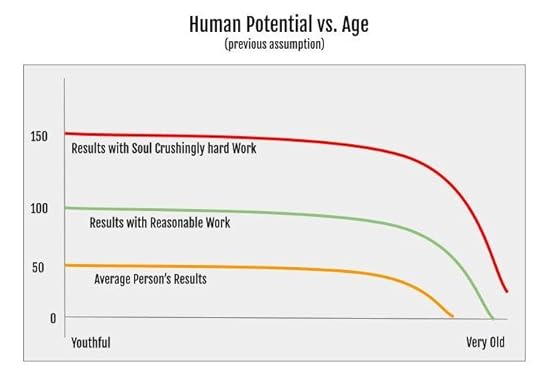 –
–I now realize that things are more like this:
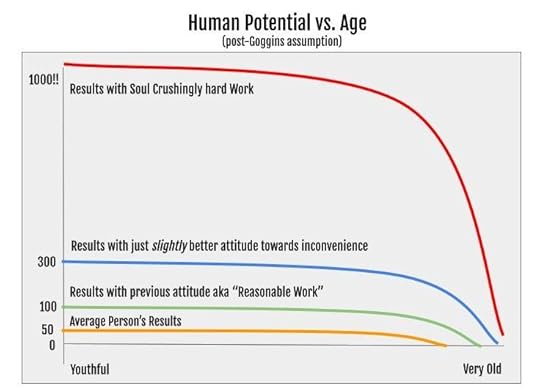 –
–And that’s a really empowering way to think about life, that feels like the sky has opened way up.
Ongoing Inspiration
So the podcast was just an introduction. I wrote down the particularly concise quote “You already fuckin’ know what to do.” on a piece of cardstock, stuck it to my bathroom mirror, and started acting on it immediately.
Suddenly, I was able to hit the gym every single day because I had two ways to approach it: wanting to put in a workout, and not wanting to put in a workout, either of which became a trigger to work out immediately.
And of course, once I finally put in the effort, it started working. Even though I’ve been sorta into this type of training since I was a teenager, I have mostly floated along on a plateau for years. But with this change in attitude, I gained ten pounds of lean weight over the first four months, returning to the strength and flexibility that I had at age 25, and every single joint in my body feels like it has been upgraded to a study, well oiled spring.
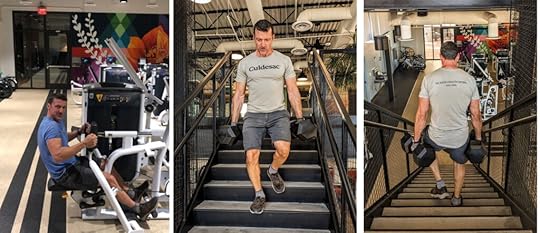 Middle aged man reclaims youth through motivation.
Middle aged man reclaims youth through motivation.I also used the “catch yourself at the moment of hesitance” trick to get myself to run instead of walk more often (over 20 runs since I got back to Colorado last month), get over to the MMM-HQ coworking space for more work and socializing visits, and even to sit back down at the computer to write this post for you. While I’ve found that too much blogger work (and internet “success”) is a bad thing, there is still a right level that works for me. But it takes a lot of discipline to be willing to do it, because of all the other easier and more thrilling activities I could be doing with this same stretch of time.
Refilling the Inspiration Tank
For me, fully internalizing this one powerful piece of inspiring profanity has been transformative. But I still find that returning regularly to the well makes all this work even better. So I downloaded both of the Goggins audiobooks and worked through them in little chunks on my morning walks over the period of a month. Then I moved on to Peter Attia’s Outlive, and Jocko Willink’s Extreme Ownership.
While the intellectuals fret about the perils of “Bro Science” or the “Toxic Masculinity” of today’s tribe of health podcasters and question their motivation, I simply absorb the messages that work for me and discard the rest. Find people who make you reach a little higher, and feed on their energy.
And for me, being exposed to successful, strong, athletic people who squeeze a lot of work out of themselves is a big source of inspiration. It helps me do more with my day, which is exactly what works for me right now at this phase of life.
And I wish you more of what works for you too!
February 3, 2024
How To Afford a House These Days

 –
–The other day, an MMM reader stopped by and left the following comment on one of my older posts about the principles of FIRE:
“While I still find some of MMM’s advice relevant, it seems like every FI blogger out there worked in tech 20 years ago, pulled down a 6 figure salary and bought a house for a bag of potatoes before 2019.I wasn’t smart enough to find FI when I was young so I sometimes feel like a lot of their advice is not going to help me or others who don’t already own a home and don’t have six- figure salaries in this post-pandemic world.
A lot of the ideas given to young folks are “house hack” “buy a fixer upper” but that is still out of reach and/or complex to navigate with current prices and interest rates. Most townships around me do not want you to chop a house up into ADU’s or multiple units. My cousin owns 60 acres of land but he is not allowed to live on a trailer on that land.
I don’t know what the next generation of FI bloggers will offer, perhaps they are already out there and I just don’t know who they are, but I’d like to hear from them.”
–
As with every critique of our ideas, I thought about this comment for a while. Tried to determine if there were any Principles of Mustachianism that were genuinely going obsolete, versus the more common side effects of Complainypants and/or Excuse-itis, two afflictions which have been weighing down our critics since the beginning.
After all, this isn’t the first time FIRE has gone obsolete. Over my retirement I’ve seen it:
written off as just a phenomenon of the lucky winners of the 2000 Tech Boomdeclared obsolete after the 2009 Financial Crisisdismissed as a temporary fluke of the spectacular stock market of the 2010sand explained away as a Covid-era side effect that came from the taste of freedom that people got from remote work.So what’s the situation right now?
Our commenter focuses on two things: the solid salaries of tech workers, and the major increases in house prices (and interest rates) in the most recent four years.
The first one — high salaries in general – is still a factor and I don’t expect that to change. Some jobs just pay more than others, and there’s a lot you can do to increase your income and switch jobs, and I’m all for it. However, ever-increasing income is not my usual focus here on MMM, because I have seen first hand that most people can waste almost any amount of income and still have very little to show for it.
In fact, the very existence of software engineers and doctors and other high earners who are my age who are still feeling financial stress is proof this: it’s mathematically impossible to earn so much for almost 30 years and not have an absolute shit-ton saved, unless you are also spending an absolute shit-ton of money the whole time.
So instead, we focus on how to streamline your spending and live joyfully and efficiently without compromise. We focus on reducing waste, while maintaining or even increasing all of the other benefits that come from spending money more purposefully. These skills are essential even for the highest earners, but they become even more valuable as you move down the income ladder.
So now for the second issue: housing. Does the state of housing here in 2024 screw up the whole FIRE plan?
As with any question, let’s start by looking at the data: how much have US house prices actually risen – adjusted for inflation – since 2019?
It turns out that our own St. Louis Fed makes this extremely useful information available here.
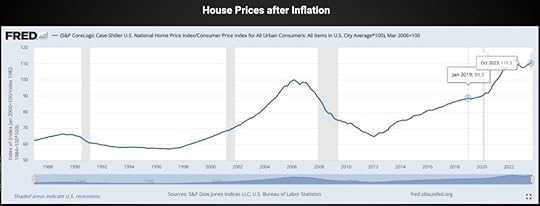
So there’s our answer: houses “feel” about 25% more expensive right now than they did at the start of 2019 relative to the average salary and the price of everything else. Although interestingly enough, they are only up about 10% since the last peak in early 2006, a full eighteen years ago! So housing is a blow, but not a FIRE-extinguishing one.
However, this nationwide data masks some much bigger increases in certain popular cities, including my own: Plain old Longmont Colorado now sports a hilariously high $540,000 median home price. This is about triple the price they were when I started writing in 2011, which means houses are much further out of reach for the average person in my area.
House Shopping With Your Middle Finger
The solution to this is the same as most other problems: to stop thinking in the way our culture likes to train us (as a victim of outside forces beyond our control) and go back to thinking like a Mustachian.
Houses are just like any other manufactured product, and as such they come at a wide variety of prices, subject to supply and demand.
And just because you happen to live in a certain place (even if you were born and raised there), doesn’t mean you’ll automatically be able to afford to buy a house there. Just as a baby born upon the Apple campus in Cupertino today doesn’t automatically get a new iPhone Pro Max every year.
With every purchasing decision, you need to go through the same series of choices:
Can I afford this thing right now?Do I need/want it enough to buy it?Are there any alternatives to meeting those same needs, and what are their pros and cons?What’s the best way to procure it, after considering all the points above?So when it comes to houses, you run the numbers, then decide between renting or buying or house hacking. You might start by doing the analysis right in your own city, but also keep in mind that there are lots of other cities and even countries in the world, and there are happy people living in all of them.
But Wait: I don’t want to move to a whole new place!
At this point, people get defensive. We all have ties to our current location, and the stronger the ties the more difficult it becomes to consider moving.
But there’s a difference between genuine, positive bonds to a place and just plain old fear of change. So it’s my job to at least make you question your assumptions, because not doing so is what got you where you are, and it’s also what got our country where it is.
And on a country-wide basis, I notice that our general fear of relocating creates a very irrational pattern of house prices. They are ridiculously high in some places and ridiculously cheap in others. There does seem to be a general correlation between niceness and cost, but not a perfect one (especially since everyone has their own definition of “nice”)
And that’s where the opportunity lies.
Example:
I moved to Longmont in 2005 because it met our young family’s needs at the time, at the right price with homes about $200,000. Today, at the $540,000 price level (houses average about $450 per interior square foot) it has to compete with a much broader range of cities which offer nicer amenities at equal or lower prices.
Let’s do a hypothetical search using another amazing tool: FRED’s list of the top 1000 metro areas with price per square foot, and plot some of them based on my own judgment of their desirability:
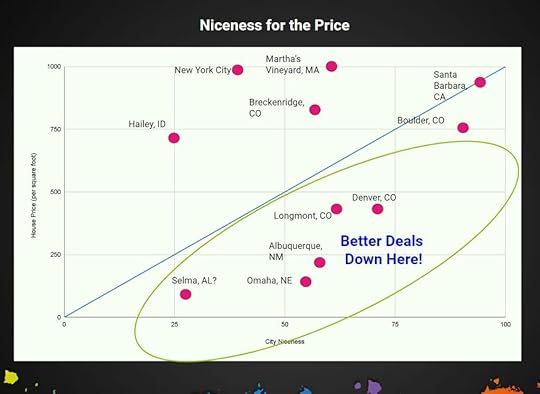 –
–I’m biased towards Colorado because I have so many ties there, and I also highly prioritize sunny climates. My chart suggests that if I wanted to save money, I might start looking around in Albuquerque, whereas Denver would give me a nicer life in the same price range, and if I were willing to spend more I should suck it up and move to Boulder.
Just for fun, I pulled the data from that same FRED website into a separate google spreadsheet (which I’ll share here) and sorted it by cost per square foot. Then, I highlighted a band of affordable cities with housing centered on the $100 per square foot range, which would mean a 2,000 square foot house is about $200k.
As an added bonus, I added a column to calculate the change in house prices over the past year, just in case it helps us see if a city is on the way up or getting cheaper at the moment.
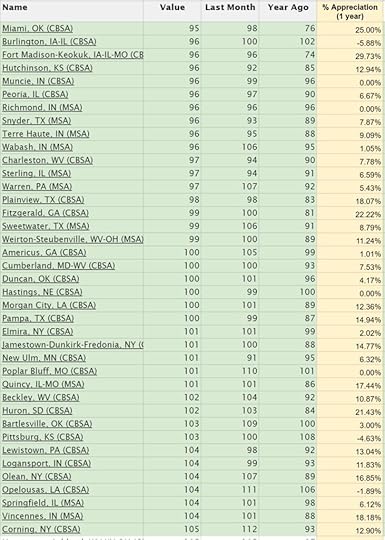 –
–A chart like this is just a starting point – you’d need to read more about any place and then go visit in person before considering a move. But the idea is to start with data, and do some fun research.
The Earth Awaits: Casting a Worldwide Net
House prices are a valuable metric, because they influence the cost of living more than almost anything else for the typical Mustachian. After all, biking and nature are always close to free, Costcos are available nationwide, and we probably care less than average about the costs of other services like valets and salons.
But there’s still plenty of value in looking at the bigger picture, considering more data points, and also being open to renting versus buying your housing. For this, I’m a big fan of a FIRE blogger-created site called The Earth Awaits, and we can take it for a test drive right now with the following search criteria:
Geographic area: North America
My total monthly budget: $0-$6000
Family size: 2
Apartment type: Two bedroom (outside city center)
Temperature range: January lows not colder than 10F
The exact parameters don’t matter too much, as long as you don’t make them too narrow. The important thing is the resulting list, which is meant to give you ideas to research further. For example, that first simple search gave me this list:
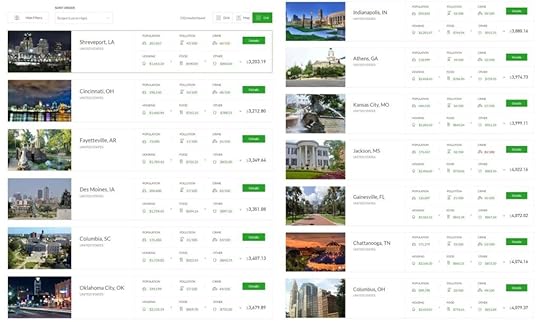 –
–Hey, that’s interesting. I like how the site shows the population right on the main list, because that provides a big clue to the “feel” of a city. I personally like the feel of a 50k-200k person town, so I might look into Fayetteville, Columbia or Athens. I’ve also been to Chattanooga and really like that place – who knew it was only about as expensive as Columbus Ohio?
So Should I Move?
In the end, your physical environment – the people, access to nature, urban features and the weather patterns – is probably the most important factor to get right in creating a happy life. The cost of living there is only one of the factors, and definitely not the most important one.
But if you choose carefully, you can probably slide yourself in the right direction along that “Nice for the Price” scale in order to get more from your life. Even if it just means making a move within your own city to live along a walking path, a little closer to work or to the people or places you care about most.
The key is just to remember that housing is like almost everything in life: It’s a choice that you get to make, and there are great rewards for putting some solid thought and effort into that choice.
Another Fun Example: Doing the Analysis on Tempe/Phoenix Arizona vs Denver
This is a fun exercise, because I’m currently living in the Phoenix area (more on that here) that is way different than the Denver metro area where I normally live. We can start with the rough measure of housing cost per square foot across each region:
Phoenix: $272
Denver: $299
In other words, pretty close. Denver metro* is about 10% higher on average, but the variations from one neighborhood to another within any major city are much larger than that anyway.
So the other factors are more important. Both are surrounded by beautiful mountain recreation and get lots of sunshine, but the climates are famously quite different. Denver is more compact but Phoenix has nicer towns in the foothills around the outskirts. In the end it’s just personal preference in weighting these various factors, and right now I kind of like the idea of both (Phoenix in winter but Colorado for the other three seasons)
More Adventurous: Let’s Try This in South America!
Going back to The Earth Awaits, if we repeat our earlier search but in South America, we get results like these:
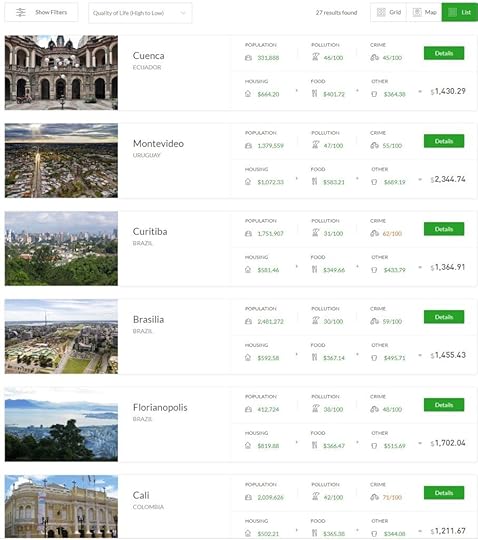 –
–Many of these spots have nice writeups if you click the “Details” button, and if anything sounds right for you, you can go on to learn much more.
It’s true that moving to a new country comes with all sorts of new learning experiences: citizenship and passports, laws and traditions and driver licenses, and of course having to cross an international border every time you want to return to your home country to visit family.
But guess what? If this stuff sounds daunting to you, it’s probably a sign that you need to do it more.
At its core, moving to a new place – even Internationally – is just a series of relatively easy Adulting Puzzles. You type stuff into your computer, read the resulting stuff that pops up on your screen, and make the occasional phone call and visit to an official office. I had to do all the same stuff when moving from Canada to the US, alone and just six years out of high school myself.
Sure, it can feel like a “hassle” if you think of it the wrong way, but you know what’s a way, way bigger hassle? Living in a not-very-good place for life, or working an extra 15 years just to afford the higher cost of living in your current city, because you’re too scared to do a few weeks of work to make a big move to a better place.
If a rules-and-paperwork-hater like me can do it, almost anyone can.
Your Turn:
While we covered a few examples of actual places in this article, the real purpose was to explain the thought process behind deciding when and where to move. And there are many of you out there besides me who can do the same thing, but better. And we’d love to hear from you!
If you have some favorite cities and countries for good living, or useful techniques for scoping them out, please share them in the comments. I strongly believe that the more we help each other find the right place and enjoy the planet more thoroughly and more efficiently, the better off we’ll all be. So let’s get moving.
—–
* Denver metro on the Fed site includes all the suburbs rather than just the core city which is much smaller and more expensive, but the same is true for the nicer parts of Phoenix so I figure it’s a fair comparison)
November 2, 2023
The Arizona Experiment!

 –
–The thing that drew me to early retirement is freedom, and that’s still the best part of it.
Back in 2005, the primary reason for this freedom-seeking was being able to devote my best hours to being a Dad – I had a feeling my career in tech would be too demanding to sustain once the full-time job of raising children kicked in.
Eighteen years later, wow has that guess ever turned out to be right. Early retirement has proved to be the most amazing, worthwhile adventure and it’s still just getting started. It was an astonishing thirteen years ago that I wrote to you about Little MM starting kindergarten, and now he’s done with high school.
It has given me the space to enjoy so many new experiences, working hard and playing hard sometimes, but also slowing things way down when necessary, to deal with and grow through some real hardships.
But now, with that child-raising phase finally almost done, I’m cashing in a few of those Freedom Chips for a particularly big change: moving to a warm sunny place for the winter to try out a new life in the walkable, bikeable, car-free community you’ve probably heard me raving about in the past: Culdesac Tempe.
So on the first of December I’ll be packing up the essential clothes, tools and gadgets, and throwing my very best mountain bike onto the Model Y to make the epic road trip across the mountains. Just in time to escape the incoming Colorado winter. And my son will be joining me for the trip!
 Heading West…
Heading West…We’ve booked ourselves a spacious two bedroom apartment there, for four full months. Little MM will be roughly alternating his months between Arizona and Colorado so he can still have time with both parents, while I’ll be there the whole time.
A big part of the fun is that this will force me to invent a whole new life for myself, away from the easy comforts of the big community and plentiful construction sites that keep me so busy here. It will be both a big change and a significant challenge, which is exactly what all of us need on a regular basis to keep life full of meaning and joy.
So What Are You Going to Do in Arizona?
 Looking forward to replacing this with a *real* Arizona mountain biking picture I will be taking soon.
Looking forward to replacing this with a *real* Arizona mountain biking picture I will be taking soon.The exact details are still in the works, and I’d love to hear your ideas and feedback (see the “get in touch” note below. But here’s what I’ve got so far:
Meet as many new people as possible, and answer the burning question we all have: what kind of people choose to move to a car-free neighborhood in the center of a super-car-based metropolis?And of course hang out with existing friends who live in the area – did you know our own Coverage Critic (aka Chris Smith) already lives in Culdesac?Share some of the experiences, whether good or bad, here on MMM and on places like Twitter and Instagram so you can live vicariously through this experience.Use my newly liberated extra free time to visit their kickass on-site gym to get in extra good shape. Use more of that free time to write more blog posts and sweep some of the cobwebs off of this neglected online persona of mine.Look at the weather app on my phone periodically to cackle at the blizzards I’m missing in Colorado and celebrate my good fortune in comparison (the typical “winter” day in Tempe is typically in the mid-70s which means sandals and palm trees and outdoor dining the whole time)Host a few meetups in Culdesac’s outdoor plazas like we did last MarchStart a quirky free handyman business where I help new residents set up their IKEA furniture and move heavy stuff and hang paintings, as a combo of meeting people and being useful and exercising my compulsion to build stuff.Ride bikes! A lot. Explore the distant corners of the Phoenix metro area and the surrounding desert valley and mountain trails on mountain bikes, regular bikes, and the e-bike that comes included with the first 200 Culdesac apartments.And perhaps most importantly, help my almost-adult son get all sorts of new experiences during his visits, by living in a brand new city for the first time since he was born waaaay back in the same era as my own early retirement. One of Culdesac’s main “parking lots”, adjoining a restaurant patio
One of Culdesac’s main “parking lots”, adjoining a restaurant patio
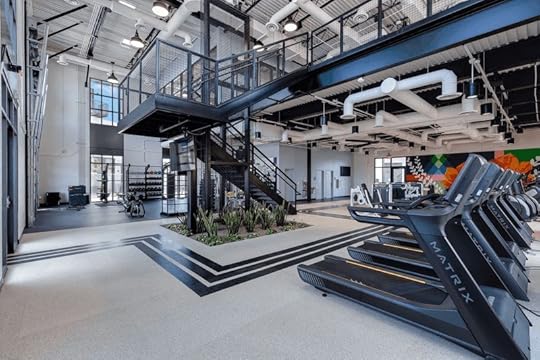 My future gym (specifically the stuff in the far background)
My future gym (specifically the stuff in the far background)Is There a Bigger Picture To All This?
Okay, you’re onto me. If I’m going to go to the trouble of typing shit into the computer and sharing it with you, there’s usually a purpose behind it other than just journaling my own personal life, and this another one of those cases.
First of all, there are the first-layer selfish goals: I want to have the best winter ever, meet a bunch of smart new people, and I also want Culdesac to be a huge success so they will build more neighborhoods like this around the country and set an example that permanently improves the way US cities build and expand themselves in the future.
 Much Better than Parking Lots
Much Better than Parking LotsBut even if you don’t care about all that, I also want to use this as a little statement about trying deliberate life changes.
By throwing myself into a new community which aligns so nicely with my own values, I hope to serve as a reminder that maybe you might want to try the same thing. Or just try anything new.
In a comfortable, prosperous country like ours, some of the built in tendencies of Human nature tend to work against us, saying,
“Hey – I’ve noticed we have plenty of food and reasonable shelter and that’s good enough.
So let’s just double down on the Netflix, comfort foods, and occasional luxury purchases and that will keep us safe.”
Instead, I want you to set your life treadmill to just a bit of a steeper, healthier incline setting.
That means questioning the status quo and doing your best to keep at least one little experiment on the go in the background. Maybe that means forcing yourself to move to a better place, or taking steps towards getting a new job that gives you a better work-life balance.
The biggest move I ever made was leaving family and friends and my old job behind to move to the US, alone, at age 24. Looking back, I’m shocked I had the courage (and the organizational skills) to pull that off back then. I’ve become older and a bit slower, and so comfortable that it’s hard to imagine doing something so bold now.
But even today 24 years later, I thank my past self every single day for doing it. My present life is an incredibly different and better thing because of that past bit of courage.
The spirit of positive experimentation might also mean starting to challenge your body more regularly – giving it harder work and exposing it to a wider swath of temperatures and movements. Or joining new Meetup groups to expand your circle of friends and experiences.
It doesn’t really matter exactly what you do, as long as you point your feet in what feels like a good direction and just start moving. Create some purposeful change, which will surely feel a bit difficult, simply because change is hard. And hard things are good.
Future Arizona Neighbors: I’ll see you in four weeks!
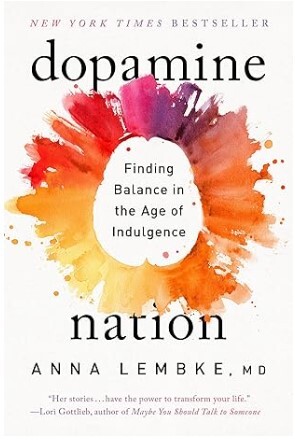
Further reading: I’ve been reading books, doing life experiments, and writing about the value of strategic hardship for a while now. But the latest is a book called Dopamine Nation by the talented psychiatrist/author named Dr. Anna Lembke.
To summarize: your brain creates a baseline for happiness based on the HARDEST thing you do, and then compares everything else to that. So if you do hard things, life in general seems fantastic because of this perspective. If you eliminate all hardship, suddenly even the pleasures of life seem bland, and you live a spoiled and unmotivated life.
To get in touch: send me a DM on Instagram or use the email address “newsletter” at the domain of this website. (Newsletter subscribers can also just reply to this post if you received it via email.)
Interested in stopping by for your own Mini Culdesac Experiment? They have a few short-term rentals available at rather reasonable rates (less than nearby hotels) – check em out at book.culdesac.com
What will you do with your car?
I’m bringing the car just as a convenient electric moving truck to carry two people and four months of living supplies. Once I get there, I’ll find a safe place to store it offsite* and live the full car-free lifestyle of Culdesac, much like I do when I’m here at home. I typically only use cars to carry really heavy stuff or for trips to other cities and states, but it’s even easier to accomplish this in Tempe with its location right on the light rail and with their onsite bike, scooter and even car sharing lots.
What about your house?
My place in Colorado is currently set up as a two bedroom house on the main floor, plus an apartment with a separate entrance on the walkout lower level. When I’m at home, I use the whole thing as one home – the apartment just makes a great place to host a fairly constant stream of visiting friends. But for the winter I’m hoping to rent out one of these spaces to a friend or trusted acquaintance who will take good care of everything, while I leave the other section free for the occasional visits I’ll be paying to this area over the winter. Aside from keeping an eye on the place, it will be a great way to practice the age-old Mustachian technique of making money while taking vacations!
What Happens at the End of March?
As it stands, I have no plans beyond this point. I’ll head back to Colorado for my home base, but with this being a new phase of life I’ll be layering on new adventures. Aside from the two mountain properties that I’ve been helping to build out, I just teamed up with a friend to help him create an intentional (and somewhat experimental!) living community in Denver called Wild Life Ranch.
We’ll have to cover more of that in a future article, but the basic idea is that he is converting a 13-acre former horse ranch in a relatively prime part of the Denver area, into a future village of higher-end tiny houses and other dwellings. These will be arranged around nice common amenities with a big emphasis on people actually enjoying the process of living together, as opposed to just living separately side-by-side as we tend to do in normal neighborhoods.
*Got any suggestions or want to rent or barter me a nearby driveway space at your place? Please get in touch!
September 4, 2023
What to Do About These High Interest Rates

Whoa, have you seen what just happened to interest rates!?
Suddenly, after at least fourteen years of our financial world being mostly the same, somebody flipped over the table and now things are quite different.
Interest rates, which have been gliding along at close to zero since before the Dawn of Mustachianism in 2011, have suddenly shot back up to 20-year highs.
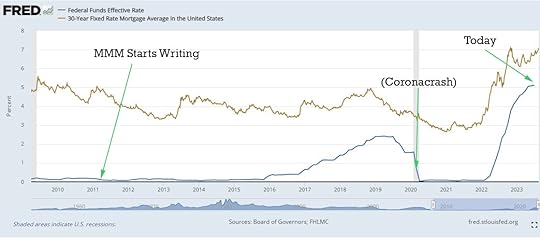
–
Which brings up a few questions about whether we need to worry, or do anything about this new development.
Is the stock market (index funds, of course) still the right place for my money?What if I want to buy a house?What about my current house – should I hang onto it forever because of the solid-gold 3% mortgage I have locked in for the next 30 years?Will interest rates keep going up? And will they ever go back down?These questions are on everybody’s mind these days, and I’ve been ruminating on them myself. But while I’ve seen a lot of play-by-play stories about each little interest rate increase in the financial newspapers, none of them seem to get into the important part, which is,
“Yeah, interest rates are way up, but what should I do about it?”
So let’s talk about strategy.
Why Is This Happening, and What Got Us Here?
 *
*Interest rates are like a giant gas pedal that revs the engine of our economy, with the polished black dress shoe of Federal Reserve Chairman Jerome Powell pressed upon it.
For most of the past two decades, Jerome’s team and their predecessors have kept the pedal to the metal, firing a highly combustible stream of easy money into the system in the form of near-zero rates. This made mortgages more affordable, so everyone stretched to buy houses, which drove demand for new construction.
It also had a similar effect on business investment: borrowed money and venture capital was cheap, so lots of entrepreneurs borrowed lots of money and started new companies. These companies then rented offices and built factories and hired employees – who circled back to buy more houses, cars, fridges, iPhones, and all the other luxurious amenities of modern life.
This was a great party and it led to lots of good things, because we had two decades of prosperity, growth, raising our children, inventing new things and all the other good things that happen in a successful rich country economy.
Until it went too far and we ended up with too much money chasing too few goods – especially houses. That led to a trend of unacceptably fast Inflation, which we already covered in a recent article.

–
So eventually, Jay-P noticed this and eased his foot back off of the Easy Money Gas Pedal. And of course when interest rates get jacked up, almost everything else in the economy slows down.
And that’s what is happening right now: mortgages are suddenly way more expensive, so people are putting off their plans to buy houses. Companies find that borrowing money is costly, so they are scaling back their plans to build new factories, and cutting back on their hiring. Facebook laid off 10,000 people and Amazon shed 27,000.
We even had a miniature banking crisis where some significant mid-sized banks folded and gave the financial world fears that a much bigger set of dominoes would fall.
All of these things sound kinda bad, and if you make the mistake of checking the news, you’ll see there is a big dumb battle raging as usual on every media outlet. Leftists, Right-wingers, and anarchists all have a different take on it:
It’s the President’s fault for printing all that money and running up the debt! We should have Fiscal Discipline! No, it’s the opposite! The Fed is ruining the economy with all these rate rises, we need to drop them back down because our poor middle class is suffering! What are you two sheeple talking about? The whole system is a bunch of corrupt cronies and we shouldn’t even have a central bank. All hail the true world currency of Bitcoin!!!The one thing all sides seem to agree on is that we are “experiencing hard economic times” and that “the country is headed in the wrong way”.
Which, ironically, is completely wrong as well – our unemployment rate has dropped to 50-year lows and the economy is at the absolute best it has ever been, a surprise to even the most grounded economists.
The reality? We’re just putting the lid back onto the ice cream carton until the economy can digest all the sugar it just wolfed down. This is normal, it happens every decade or two and it’s no big deal.
Okay, but should I take my money out of the stock market because it’s going to crash?
This answer never changes, so you’ll see it every time we talk about stock investing: Holy Shit NO!!!
The stock market always goes up in the long run, although with plenty of unpredictable bumps along the way. Since you can’t predict those bumps until after they happen, there is no point in trying to dance in and out of it.
But since we do have the benefit of hindsight, there are a few things that have changed slightly: From its peak at the beginning of 2022 until right now (August 2023 as I write this), the overall US market is down about 10%. Or to view it another way, it is roughly flat since June 2021, so we’ve seen two years with no gains aside from total dividends of about 3%.
Since the future is always the same, unknowable thing, this means I am about 10% more excited about buying my monthly slice of index funds today than it was at the peak.
Should I start putting money into savings accounts instead because they are paying 4.5%?
This is a slightly trickier question, because in theory we should invest in a logical, unbiased way into the thing with the highest expected return over time.
When interest rates were under 1%, this was an easy decision: stocks will always return far more than 1% over time – consider the fact that the annual dividend payments alone are 1.5%!
But there has to be some interest rate at which you’d be willing to stop buying stocks and prefer to just stash it into the stable, rewarding environment of a money market fund or long-term bonds or something else similar. Right now, if a reputable bank offered me, say, 12% I would probably just start loading up.
But remember that the stock market is also currently running a 10% off sale. When the market eventually reawakens and starts setting new highs (which it will someday), any shares I buy right now will be worth 10% more. And then will continue going up from there. Which quickly becomes an even bigger number than 12%.
In other words, the cheaper the stocks get, the more excited we should be about buying them rather than chasing high interest rates.
As you can see, there is no easy answer here, but I have taken a middle ground:
I’m holding onto all the stocks I already own, of course BUT since I currently have an outstanding margin loan balance for a house I helped to buy with several friends (yes this is #3 in the last few years!), I am paying over 6% on that balance. So I am directing all new income towards paying down that balance for now, just for peace of mind and because 6% is a reasonable guaranteed return.Technically, I know I would probably make a bit more if I let the balance just stay outstanding, kept putting more money into index funds, and paid the interest forever, but this feels like a nice compromise to meWhat if I want to Buy a House?

–
For most of us, the biggest thing that interest rates affect is our decisions around buying and selling houses. Financing a home with a mortgage is suddenly way more expensive, any potential rental house investments are suddenly far less profitable, and keeping our old house with a locked-in 3% mortgage is suddenly far more tempting.
Consider these shocking changes just over the past two years as typical rates have gone from about 3% to 7.5%.
Assuming a buyer comes up with the average 10% down payment:
The monthly mortgage payment on a $400k house has gone from about $1500 at the beginning of 2022 last year to roughly $2500 today. Even scarier, the interest portion of that monthly bill has more than doubled, from $900 to $2250!For a home buyer with a monthly mortgage budget of $2000, their old maximum house price was about $500,000. With today’s interest rates however, that figure has dropped to about $325,000Similarly, as a landlord in 2022 you might have been willing to pay $500k for a duplex which brought in $4000 per month of gross rent. Today, you’d need to get that same property for $325,000 to have a similar net cash flow (or try to rent each unit for a $500 more per month) because the interest cost is so much higher.And finally, if you’re already living in a $400k house with a 3% mortgage locked in, you are effectively being subsidized to the tune of $1000 per month by that good fortune. In other words, you now have a $12,000 per year disincentive to ever sell that house if you’ll need to borrow money to buy a new one. And you have a potential goldmine rental property, because your carrying costs remain low while rents keep going up.This all sounds kind of bleak, but unfortunately it’s the way things are supposed to work – the tough medicine of higher interest rates is supposed to make the following things happen:
House buyers will end up placing lower bids which fit within their budgets.Landlords will have to be more discerning about which properties to buy up as rentals, lowering their own bids as well.Meanwhile, the current still-sky-high prices of housing should continue to entice more builders to create new homes and redevelop and upgrade old buildings and underused land, because high prices mean good profits. Then they’ll have to compete for a thinner supply of home buyers.The net effect of all this is that prices should stop going up, and ideally fall back down in many areas.
When Will House Prices Go Back Down?
This is a tricky one because the real “value” of a house depends entirely on supply and demand. The right price is whatever you can sell it for. However, there are a few fundamentals which influence this price over the long run because they determine the supply of housing.
The actual cost of building a house (materials plus labor), which tends to just stay pretty flat – it might not even keep up with inflation. The value of the underlying land, which should also follow inflation on average, although with hot and cold spots depending on which cities are popular at the time.The amount of bullshit which residents and their city councils impose upon house builders, preventing them from producing the new housing that people want to buy. NIMBYS in my own area, damaging the housing market.
NIMBYS in my own area, damaging the housing market.The first item (construction cost) is pretty interesting because it is subject to the magic of technological progress. Just as TVs and computers get cheaper over time, house components get cheaper too as things like computerized manufacturing and global trade make us more efficient. I remember paying $600 for a fancy-at-the-time undermount sink and $400 for a faucet for my first kitchen remodel in the year 2001. Today, you can get a nicer sink on Amazon for about $250 and the faucet is a flat hundred. Similarly, nailguns and cordless tools and easy-to-install PEX plumbing make the process of building faster and easier than ever.
On the other hand, the last item (bullshit restrictions) has been very inflationary in recent times. I’ve noticed that every year another layer of red tape and complicated codes and onerous zoning and approval processes gets layered into the local book of rules, and as a result I just gave up on building new houses because it wasn’t worth the hassle. Other builders with more patience will continue to plow through the murk, but they will have less competition, fewer permits will be granted, and thus the shortage of housing will continue to grow, which raises prices on average.
Thankfully, every city is different and some have chosen to make it easier to build new houses rather than more difficult. Even better, places like Tempe Arizona are allowing good housing to be built around people rather than cars, which is even more affordable to construct.
But overall, since overall US house prices adjusted for inflation are just about at an all-time high, I think there’s a chance that they might ease back down another 25% (to 2020 levels). But who knows: my guess could prove totally wrong, or the “fall” could just come in the form of flat prices for a decade that don’t keep up with inflation, meaning that they just feel 25% cheaper relative to our higher future salaries.
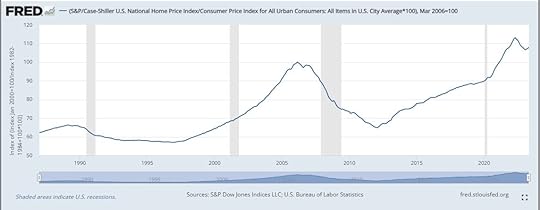
–
When Will Interest Rates Go Back Down?
The funny part about our current “high” interest rates is that they are not actually high at all. They’re right around average.So they might not go down at all for a long time.
Remember that graph at the beginning of this article? I deliberately cropped it to show only the years since 2009 – the long recent period of low interest rates. But if you zoom out to cover the last seventy years instead, you can see that we’re still in a very normal range.
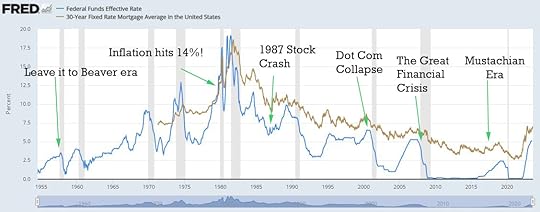
–
But a better answer is this one: Interest rates will go down whenever Jerome Powell or one of his successors determines that our economy is slowing down too much and needs another hit from the gas pedal. In other words, whenever we start to slip into a genuine recession.
In order to do that however, we need to see low inflation, growing unemployment, and other signs of an economy that’s not too hot. And right now, those things keep not showing up in the weekly economic data.
You can get one reasonable prediction of the future of interest rates by looking at something called the US Treasury Yield Curve. It typically looks like this:
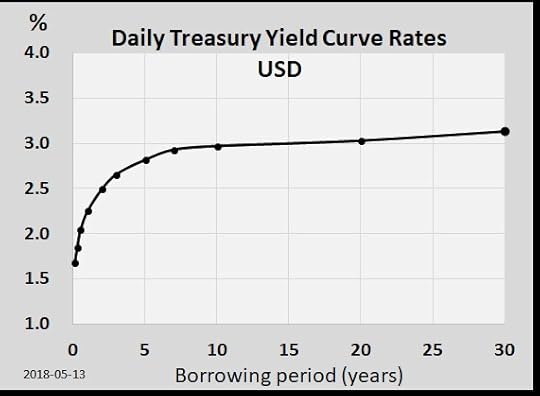
–
What the graph is telling you is that as a lender you get a bigger reward in exchange for locking up your money for a longer time period. And way back in 2018, the people who make these loans expected that interest rates would average about 3.0 percent over the next 30 years.
Today, we have a very strange opposite yield curve:
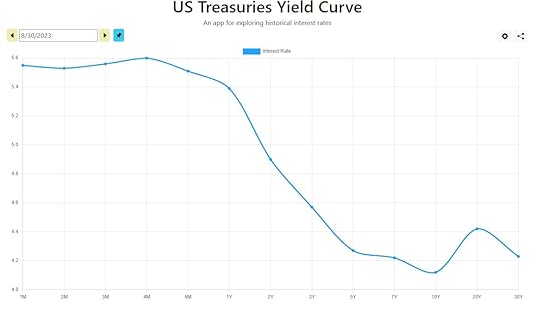
–
If you want to lend money for a year or less, you’ll be rewarded with a juicy 5.4 percent interest rate. But for two years, the rate drops to 4.92%. And then ten-year bond pays only 4.05 percent.
This situation is weird, and it’s called an inverted yield curve. And what it means is that the buyers of bonds currently believe that interest rates will almost certainly drop in the future – starting a little over a year from now.
And if you recall our earlier discussion about why interest rates drop, this means that investors are forecasting an economic slowdown in the fairly near future. And their intuition in this department has been pretty good: an inverted yield curve like this has only happened 11 times in the past 75 years, and in ten of those cases it accurately predicted a recession.
So the short answer is: nobody really knows, but we’ll probably see interest rates start to drop within 18-24 months, and the event may be accompanied by some sort of recession as well.
The Ultimate Interest Rate Strategy Hack

–
I like to read and write about all this stuff because I’m still a finance nerd at heart. But when it comes down to it, interest rates don’t really affect long-retired people like many of us MMM readers, because we are mostly done with borrowing. I like the simplicity of owning just one house and one car, mortgage-free.
With the current overheated housing market here in Colorado, I’m not tempted to even look at other properties, but someday that may change. And the great thing about having actual savings rather than just a high income that lets you qualify for a loan, is that you can be ready to pounce on a good deal on short notice.
Maybe the entire housing market will go on sale as we saw in the early 2010s, or perhaps just one perfect property in the mountains will come up at the right time. The point is that when you have enough cash to buy the thing you want, the interest rates that other people are charging don’t matter. It’s a nice position of strength instead of stress. And you can still decide to take out a mortgage if you do find the rates are worthwhile for your own goals.
So to tie a bow on this whole lesson: keep your lifestyle lean and happy and don’t lose too much sweat over today’s interest rates or house prices. They will probably both come down over time, but those things aren’t in your control. Much more important are your own choices about earning, saving, healthy living and where you choose to live.
With these big sails of your life properly in place and pulling you ahead, the smaller issues of interest rates and whatever else they write about in the financial news will gradually shrink down to become just ripples on the surface of the lake.
In the comments: what have you been thinking about interest rates recently? Have they changed your decisions, increased, or perhaps even decreased your stress levels around money and housing?
—
* Photo credit: Mr. Money Mustache, and Rustoleum Ultra Cover semi gloss black spraypaint. I originally polled some local friends to see if anyone owned dress shoes and a suit so I could get this picture, with no luck. So I painted up my old semi-dressy shoes and found some clean-ish black socks and pants and vacuumed out my car a bit before taking this picture. I’m kinda proud of the results and it saved me from hiring Jerome Powell himself for the shoot.
Mr. Money Mustache's Blog
- Mr. Money Mustache's profile
- 60 followers



